1lumen selects and reviews products personally. We may earn affiliate commissions through our links, which help support our testing.
Fenix LD30R review
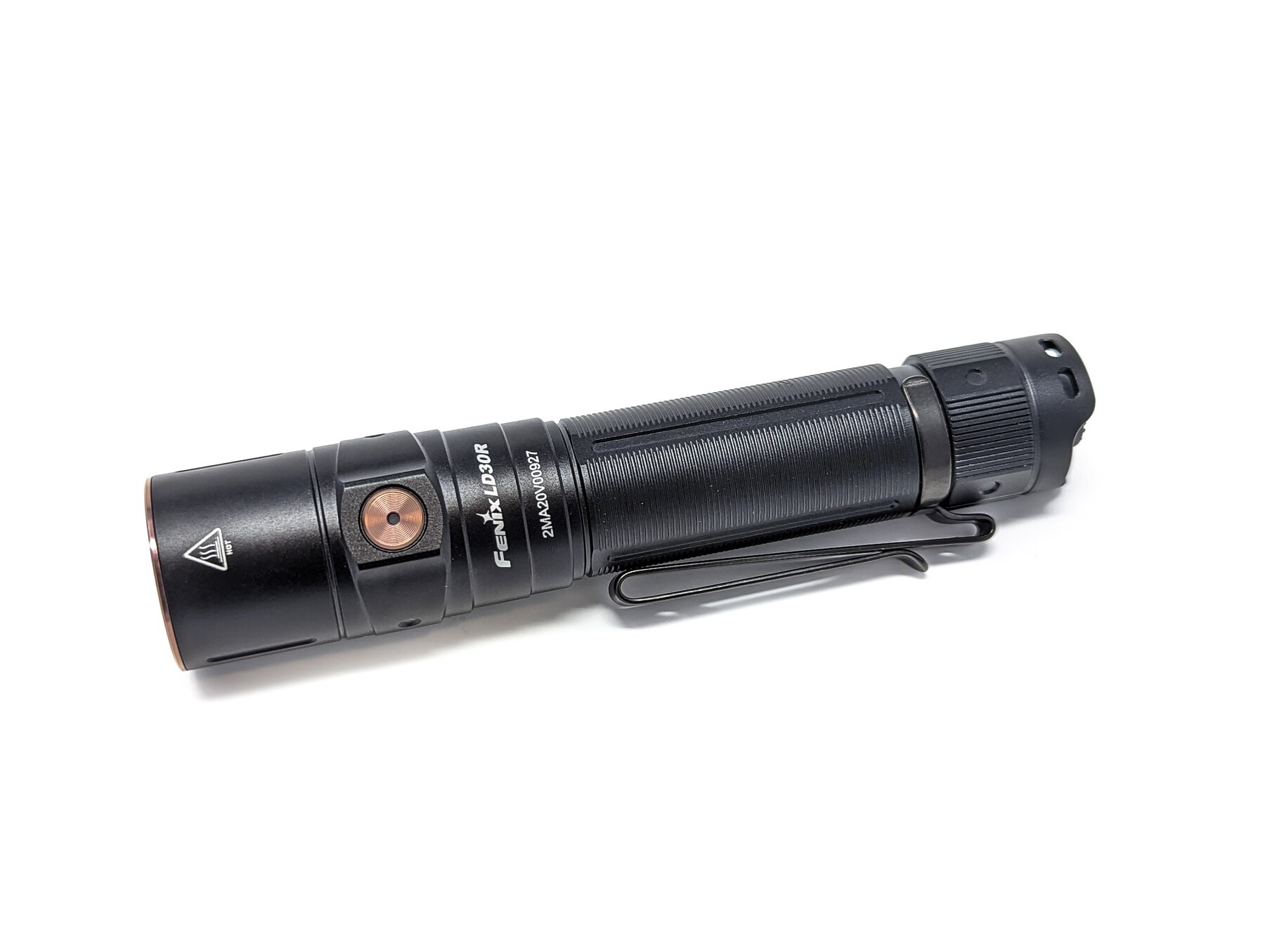
Fenix LD30R specs
| Brand & Model | Fenix LD30R |
|---|---|
| Flashlight category | EDC |
| LED | Luminus SST40 |
| Max. output | 1,700 lumens |
| Max. beam distance | 257 meters |
| Max. beam intensity | 18,037 cd |
| Battery config. | 1x 18650 |
| Onboard charging | USB-C |
| Main modes | 5 |
| Blinkies | SOS, Strobe |
| Waterproof | IP68 |
| Review publication date | December 2023 |
Review intro:
Fenix makes a huge array of lights. In fact, they have an actual PDF catalog on their website (I imagine it’s probably also distributed in paper form as well) that is 48 pages long and chock-full of products ranging from tiny EDC lights all the way up to a couple really big boys that I’ve been fortunate enough to check out: the Fenix LR50R 12,000 lumen monstrosity and the Fenix HT30R 1500m throw LEP. If you need a light, chances are that Fenix will have a nice offering to fill that need.
From my experience, Fenix lights are really well designed, they use quality materials and finishes, have great constant-current drivers, and publish truthful ANSI specs. I recently reviewed the small LD12R dual-LED EDC light and the professional-focused PD36R V2.0, which were both very nice entries in the lineup.
The flashlight on the menu today is the new Fenix LD30R. As noted on the Fenix Lighting website, the LD30R is named after the older LD30 model, but “they are very different lights in size and performance.” I’m not too sure about the performance aspect as I haven’t tested the LD30 and the specs really aren’t that different. However, the LD30R is a fair bit longer and has a built-in USB-C charging port. The LD30R is geared towards EDC / outdoor usage and has a pretty nice feature set.
Before starting with the Fenix LD30R, make sure to remove the battery isolation disc!
Package quality.
The packaging for the Fenix LD30R is instantly recognizable as having come off the same line as the other Fenix models that I recently reviewed. They used the exact same design language and materials: a showy black and orange carton with a heavy duty plastic tray inside. I think it’s great that Fenix is using consistent packaging as it helps drive brand recognition. Arranged in the tray was:
- Fenix LD30R
- Battery
- Charging cable
- Spare o-ring
- Holster
- Pocket clip (pre-installed)
- Lanyard
- Manual and other literature
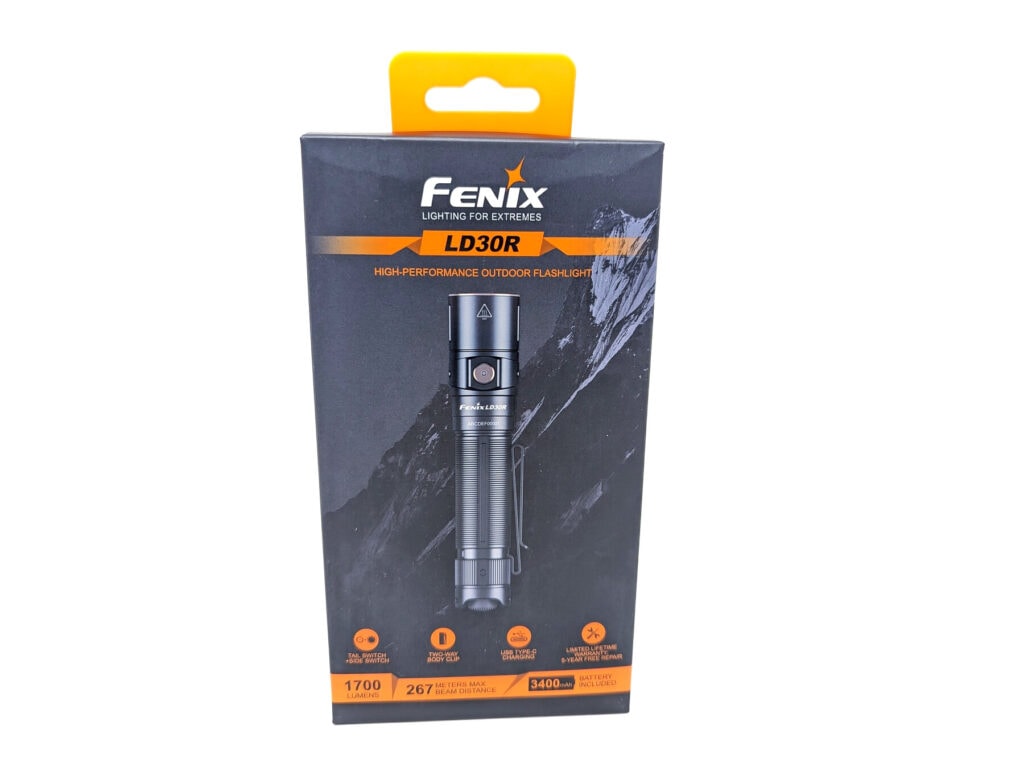
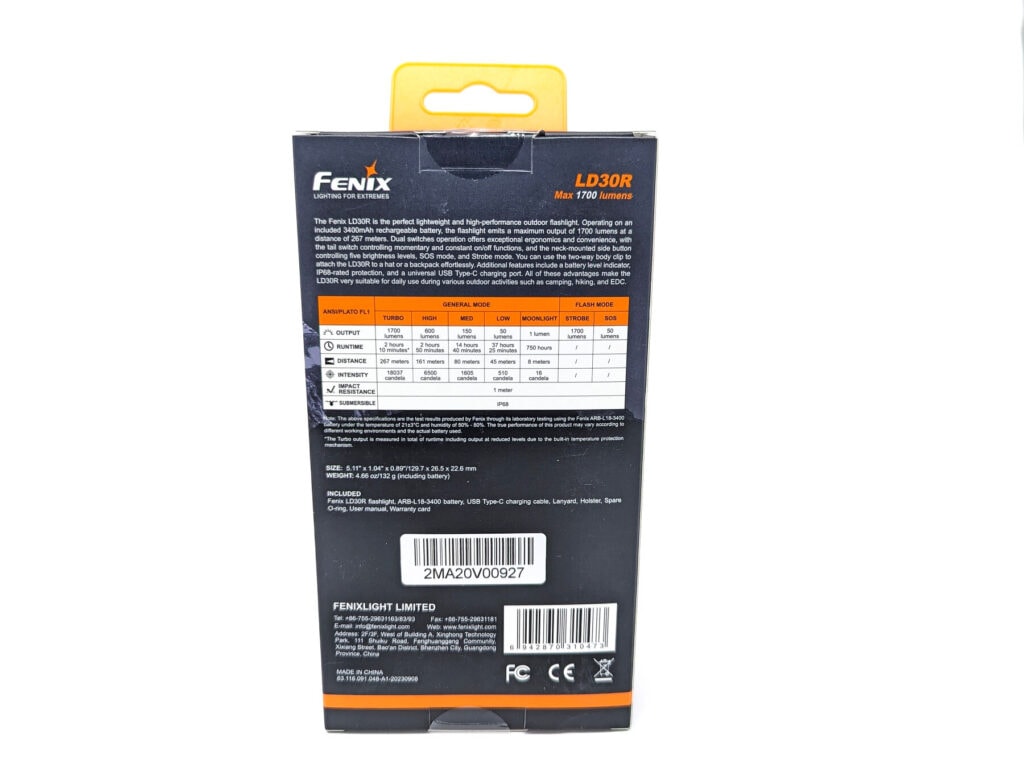
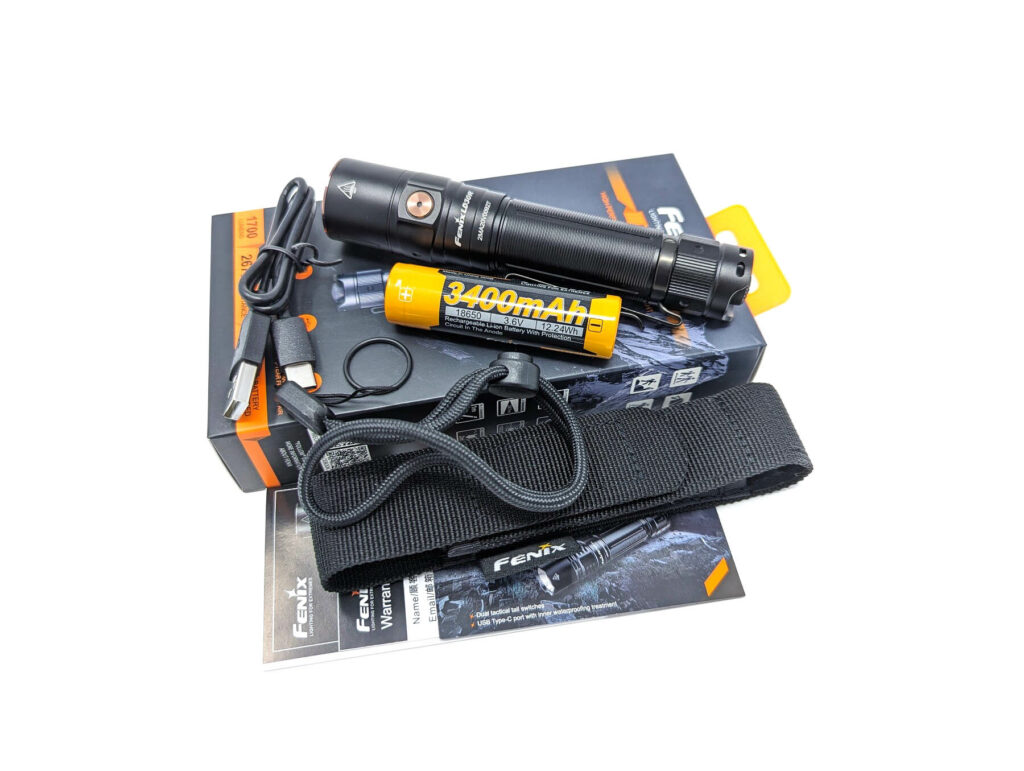
Flashlight in use, Build Quality, and Warranty
Several of the Fenix lights that I’ve reviewed lately have been 21700-based models. I like 21700 for its energy density, but sometimes that increase in size just pushes it over the dimensional boundary of “EDC” for some people. I personally prefer even smaller (typically 14500) lights to keep in my pocket, but that’s only because I only use my flashlight sporadically and generally for short-lived tasks. If you have a more demanding routine and frequently use a flashlight throughout the day and still want something that can comfortably fit in your pocket, a 18650-based flashlight like the Fenix LD30R may just be the ticket.
The Fenix LD30R is pretty sleek and easy to use. It features a traditional 2-button setup: a momentary clicky tail switch paired with an e-switch on the side of the head. The tail switch is for on/off duties, while the e-switch is for mode switching. A decent two-way clip comes preinstalled on the LD30R. I’m not really sure of a decent use-case for having the flashlight ride head-up in your pocket and I really wouldn’t want to clip this onto the brim of a ballcap, so I’m not sure why they went with a two-way clip except perhaps that it seems like most lights are using one these days. If the clip isn’t your thing, you can always attach the included lanyard or perhaps use the included holster. I don’t use holsters too often, but they can be handy if you don’t mind it riding on your hip.
There’s a lot of tasks that would be suitable for the Fenix LD30R. Like I said before, as a general EDC if you don’t mind a 18650 flashlight. The LD30R would also be good for camping, hunting, hiking, or walks around the neighborhood or yard.
As far as construction goes, we’re looking at A6061-T6 aluminum, which is typical as far as flashlights go. Fenix then coated it with a premium Type III hard-anodization. All in all, though, it is well executed and seems high quality – exactly what I expect of a reputable brand like Fenix.
Warranty:
- 15 days from date of purchase: replacement from Fenix for manufacturing defects
- 5 year from date of purchase: free repairs
- Lifetime maintenance, with customer covering the cost of parts
- Extra 6 month warranty period for products registered on Fenix’s website
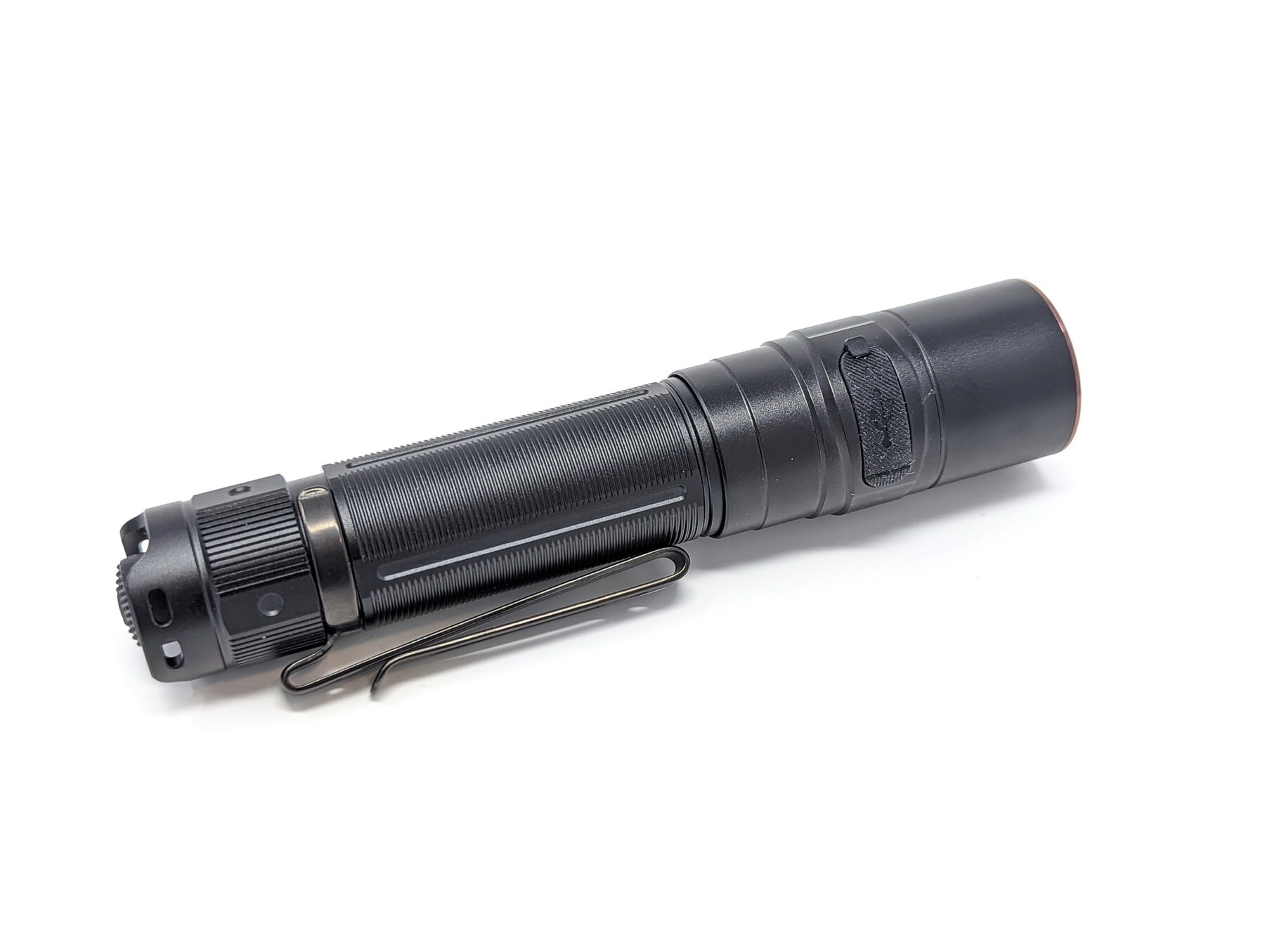
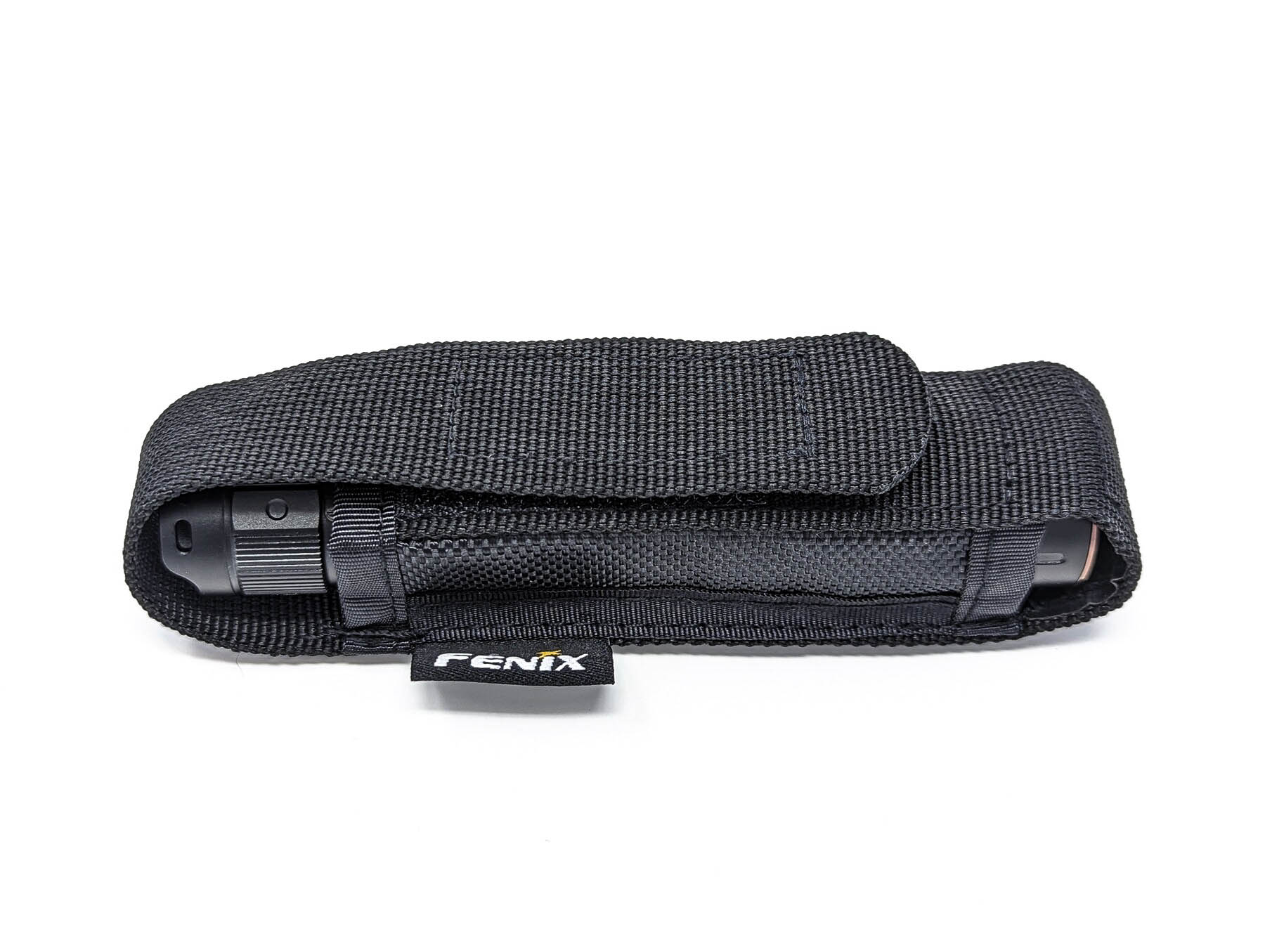
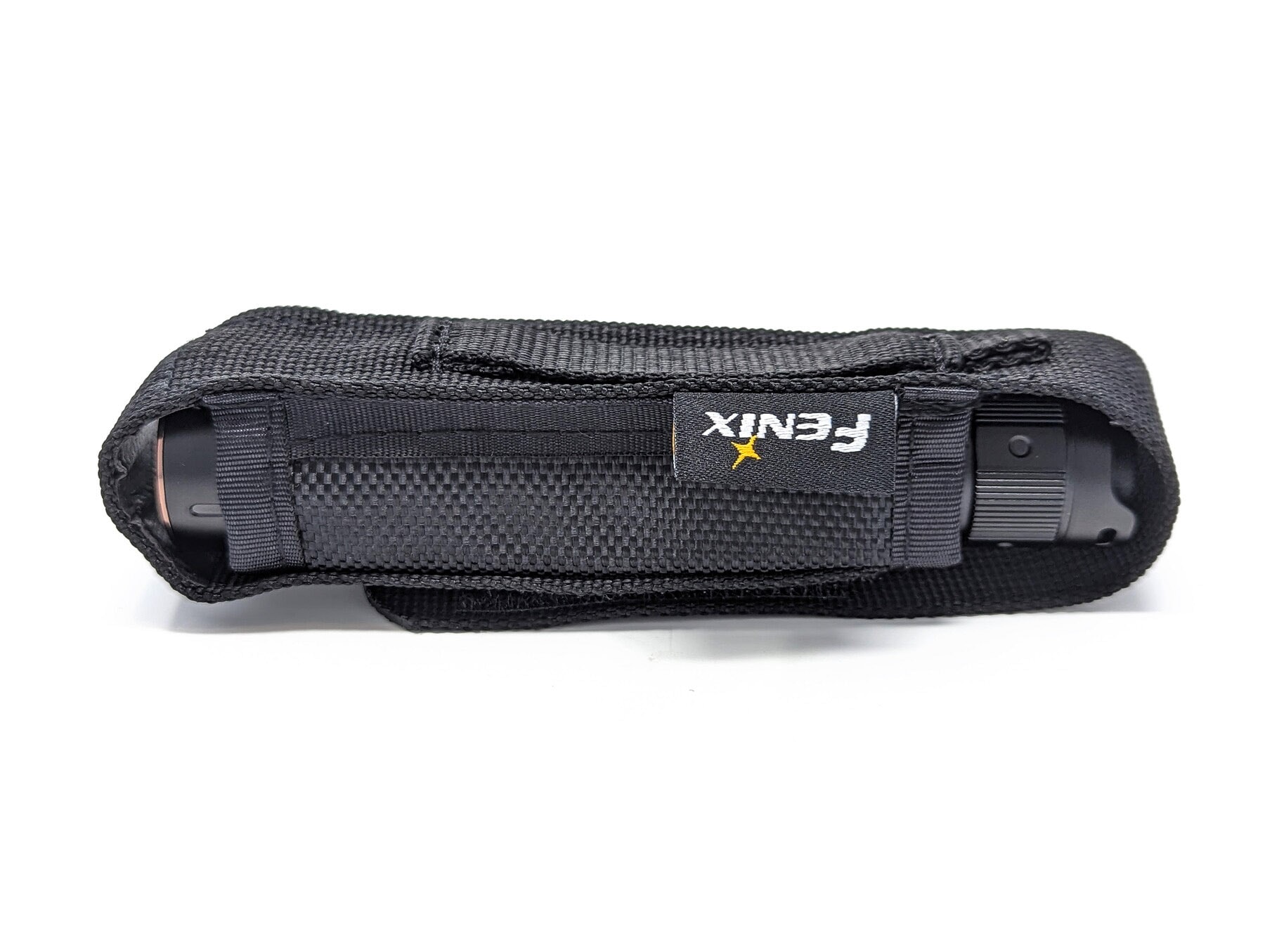
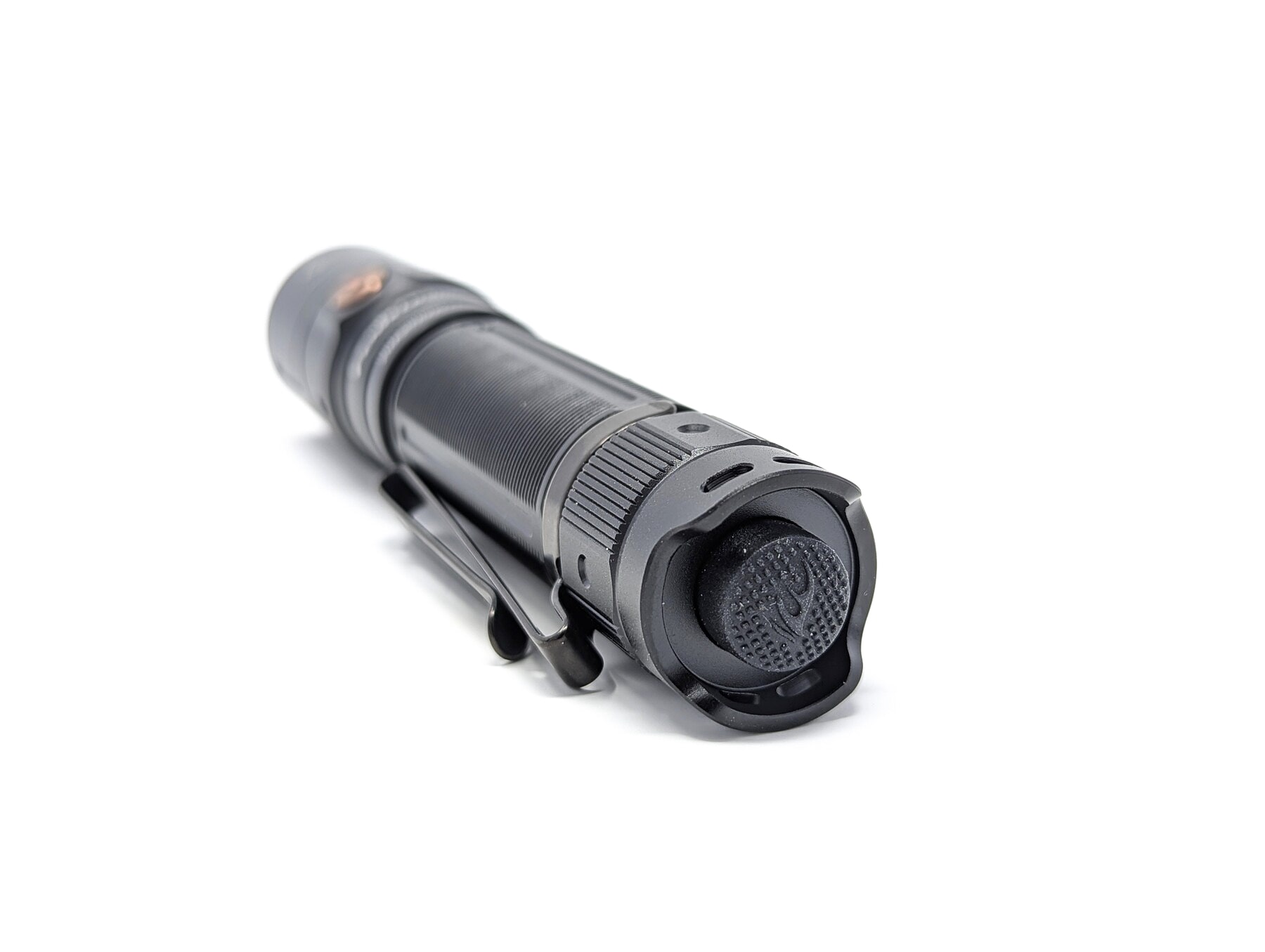
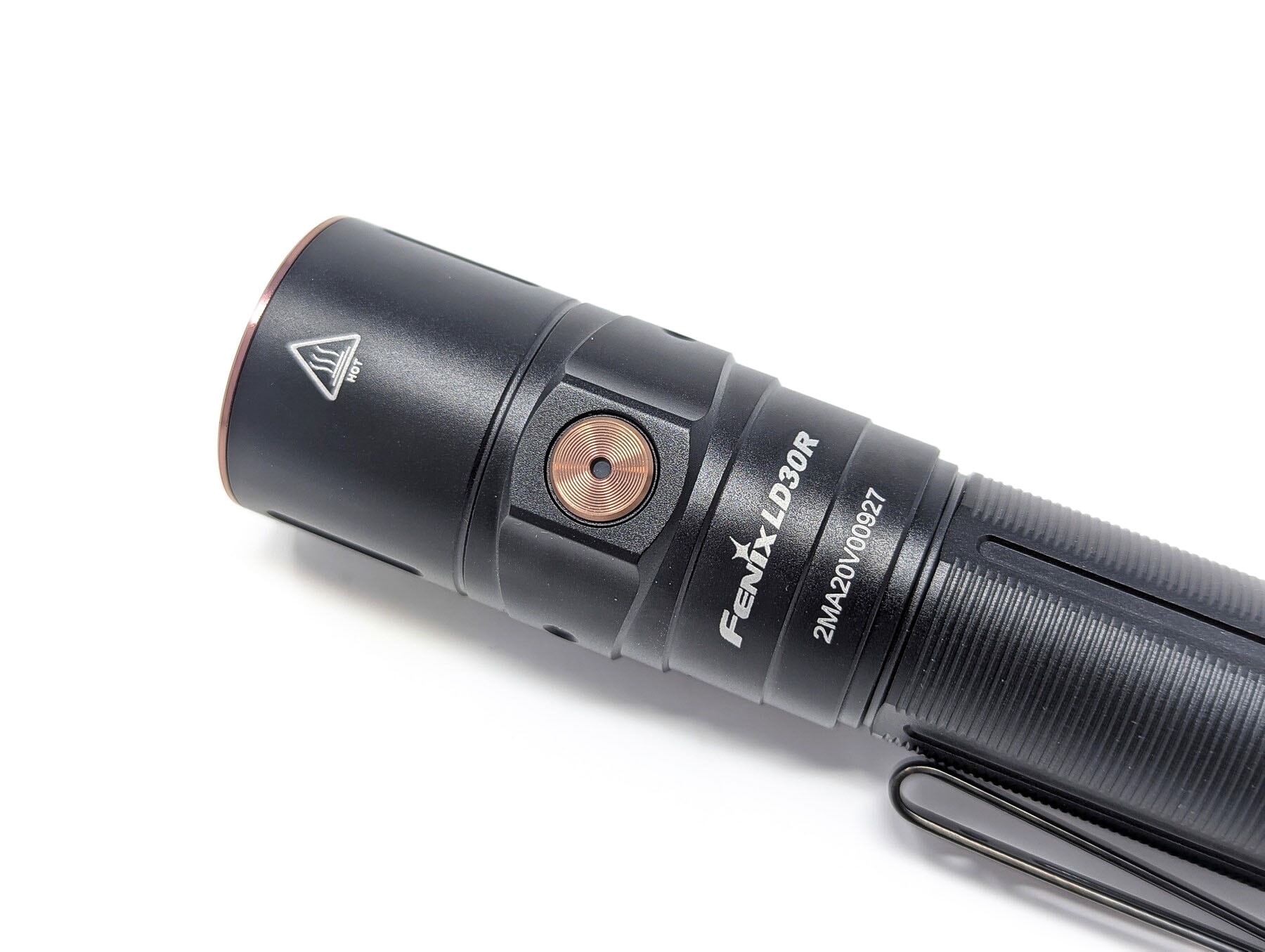
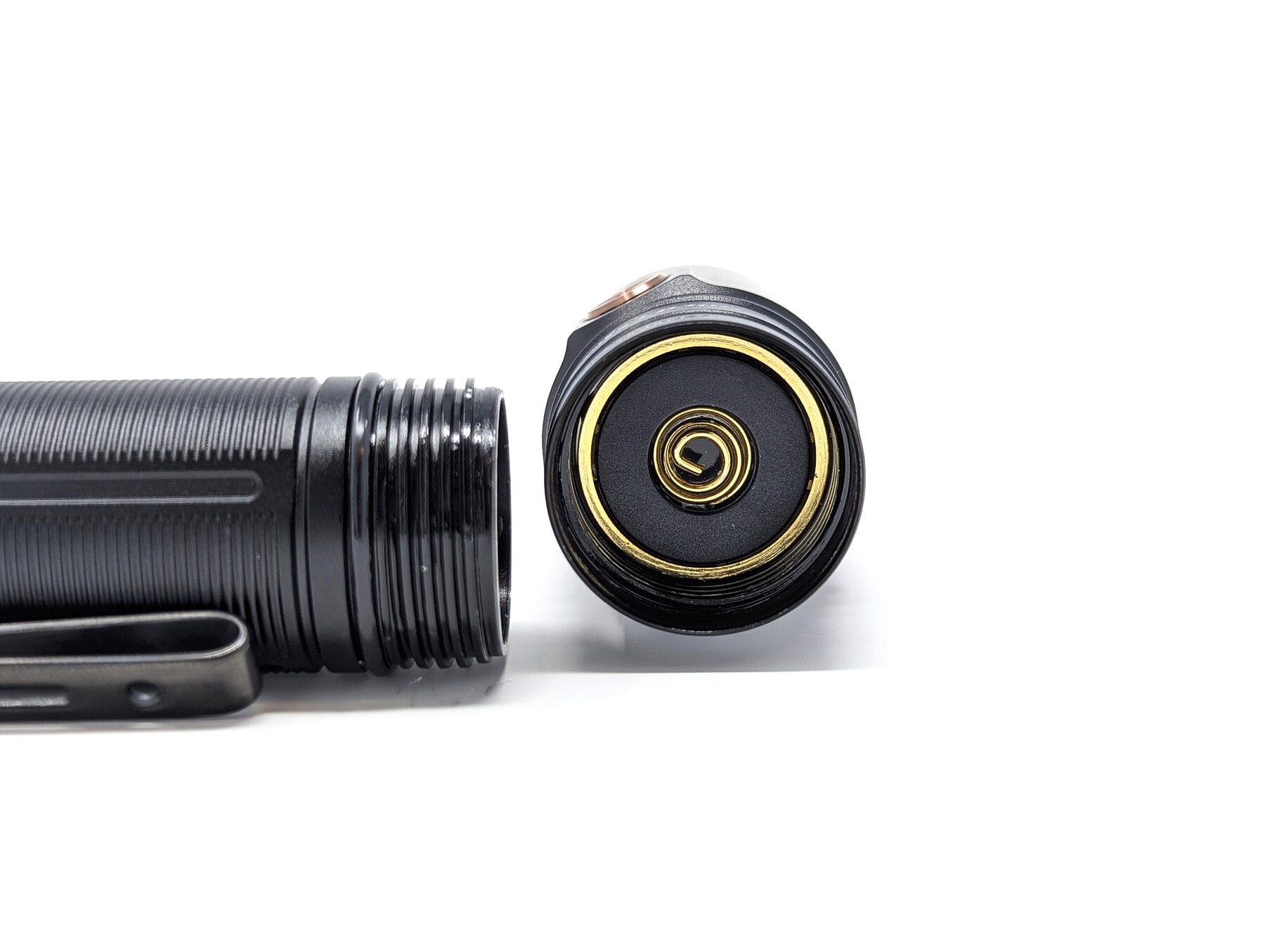
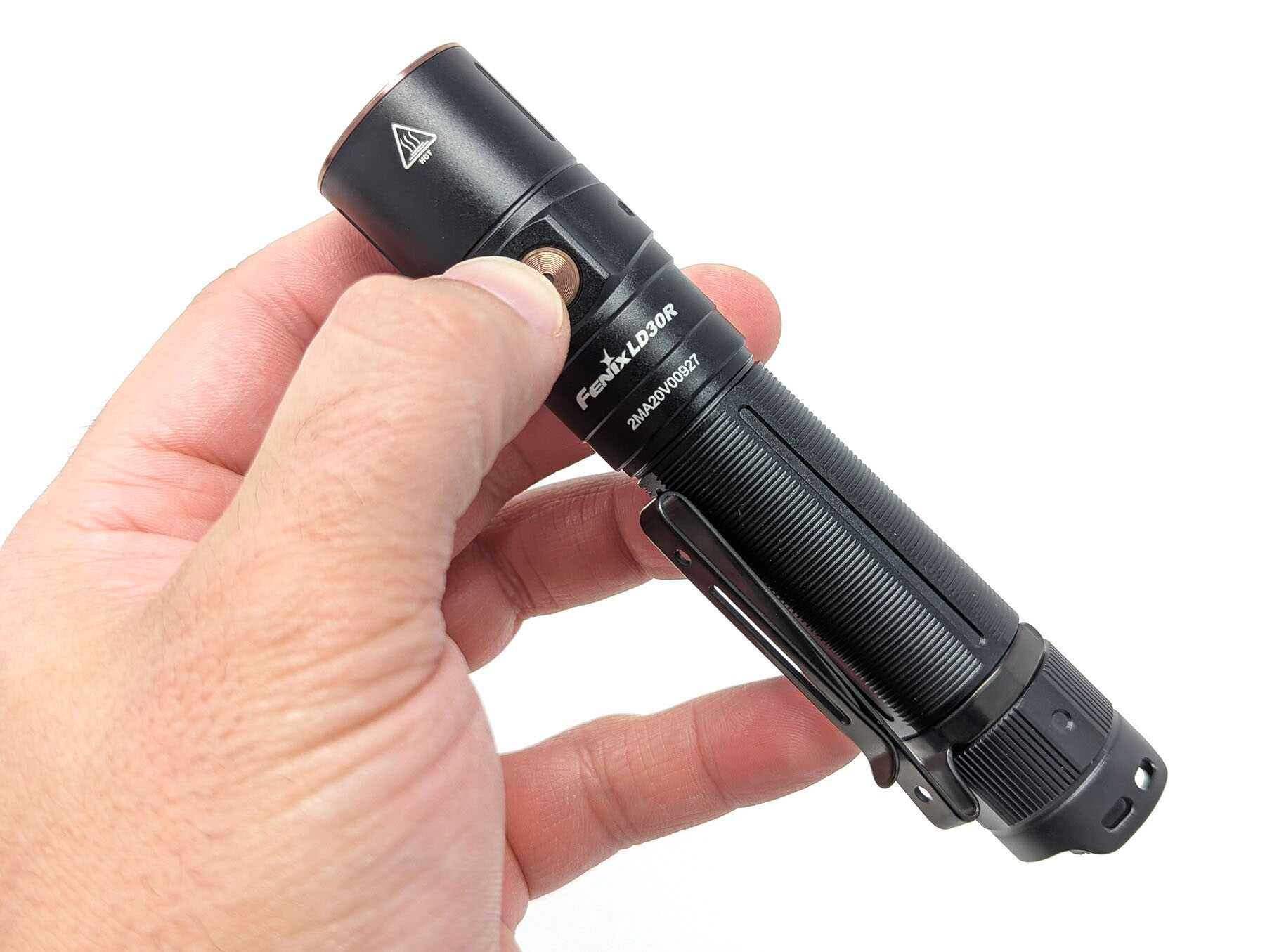
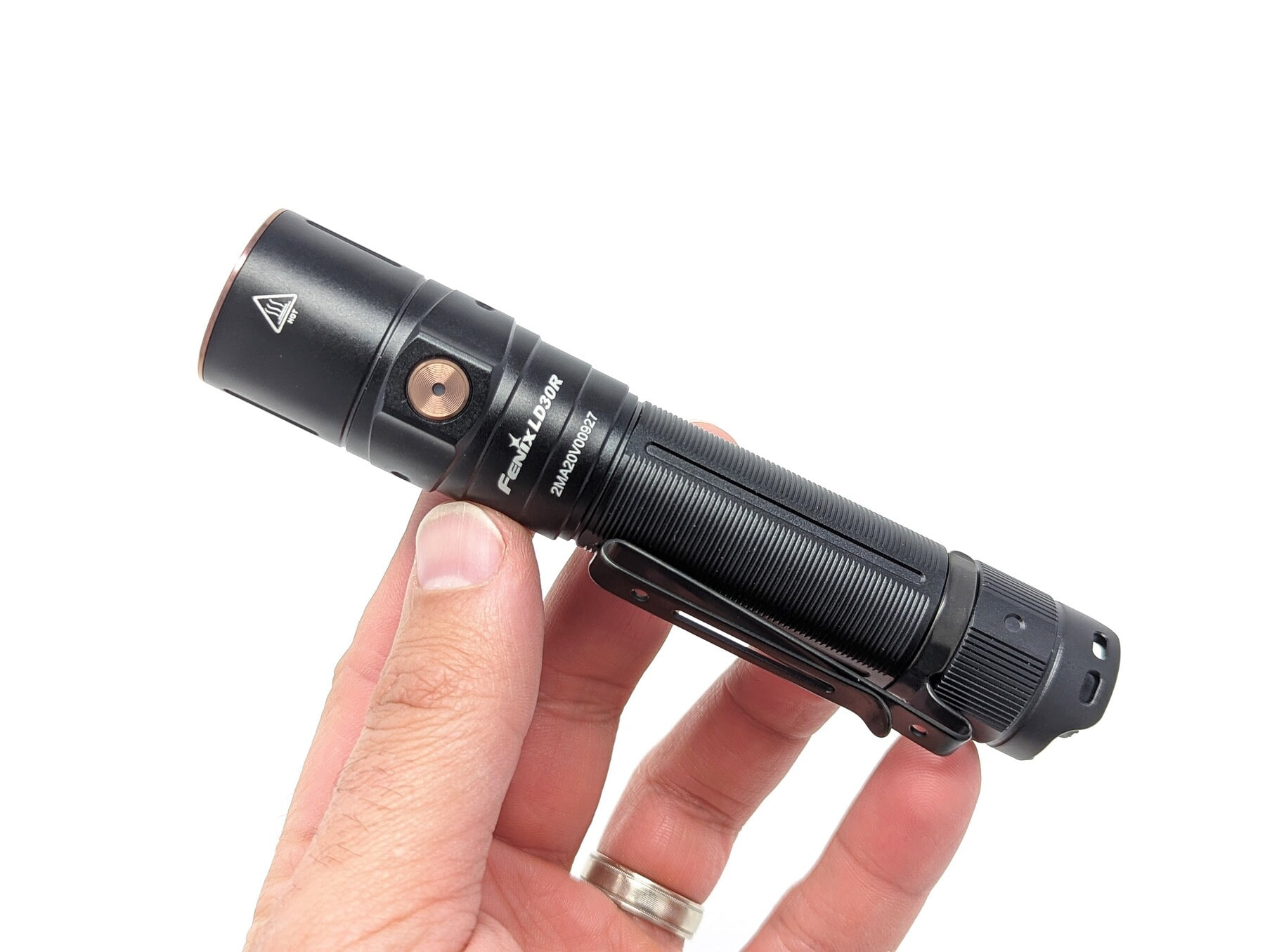
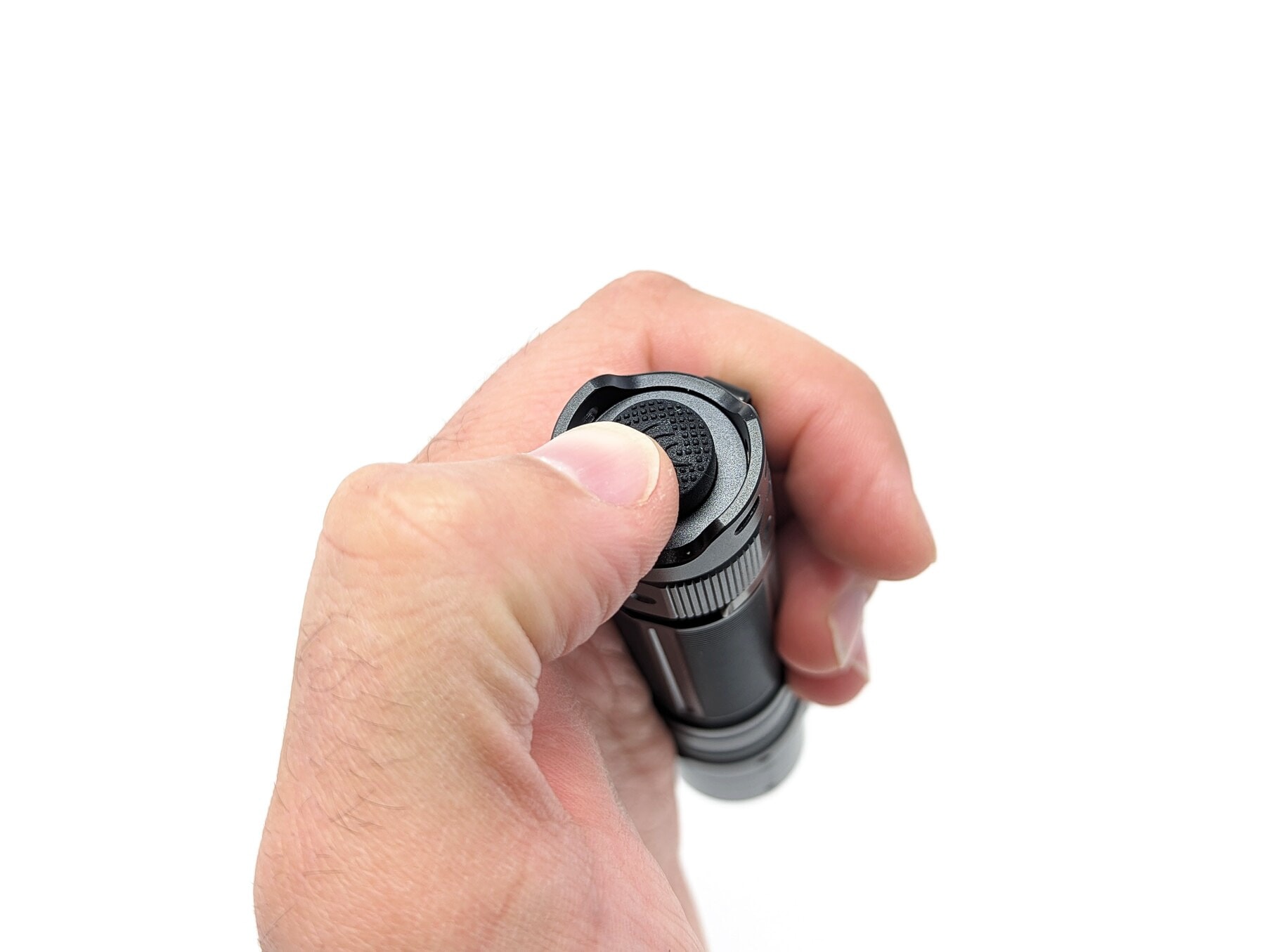
LED, Lens, Bezel, Beam, and Reflector
Fenix went with the Luminus SST40 LED in 6000K for the LD30R. This is a domed 5050 LED that has made its way into a lot of flashlights lately. It won’t win any beauty contests, but it is durable, powerful, and high-efficacy. The SST40 is nicely centered in a smallish, smooth reflector to make a balanced beam profile. There’s a mid-sized hotspot that is surrounded by a largish mid-corona, and a mildly large spill. The hotspot has a slight (but not obnoxious) green tint, as expected from a cool white SST40, and there is a little bit of a tint shift outside of the hotspot.
The reflector and LED are protected by a sheet of anti-reflective coated glass. The glass is held in place by the bronze-colored smooth stainless bezel. Overall, the beam isn’t too bad. But I think using a TIR lens, like the LD30 employs, might not have been a bad idea. Or perhaps an orange peel reflector.
Spectral measurements:
I used an Opple Light Master to measure the flashlight at 5 meters distance.
| Mode: | CCT: | CRI Ra: | duv |
|---|---|---|---|
| Turbo | 6085 K | 66.6 | +0.0065 |
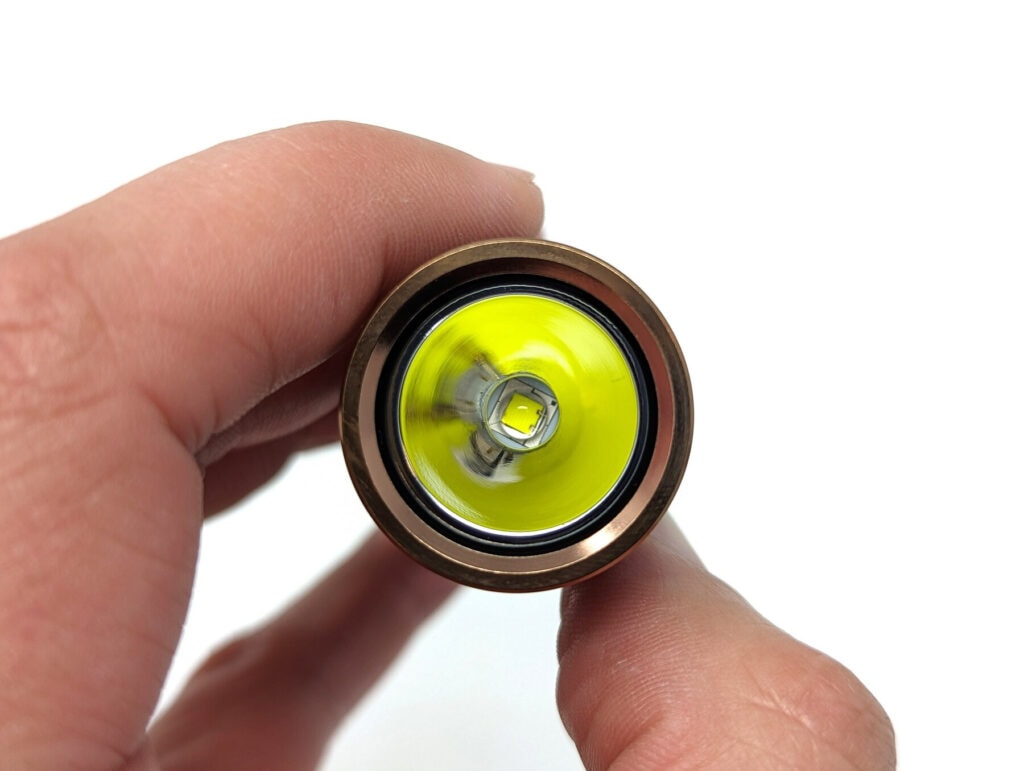
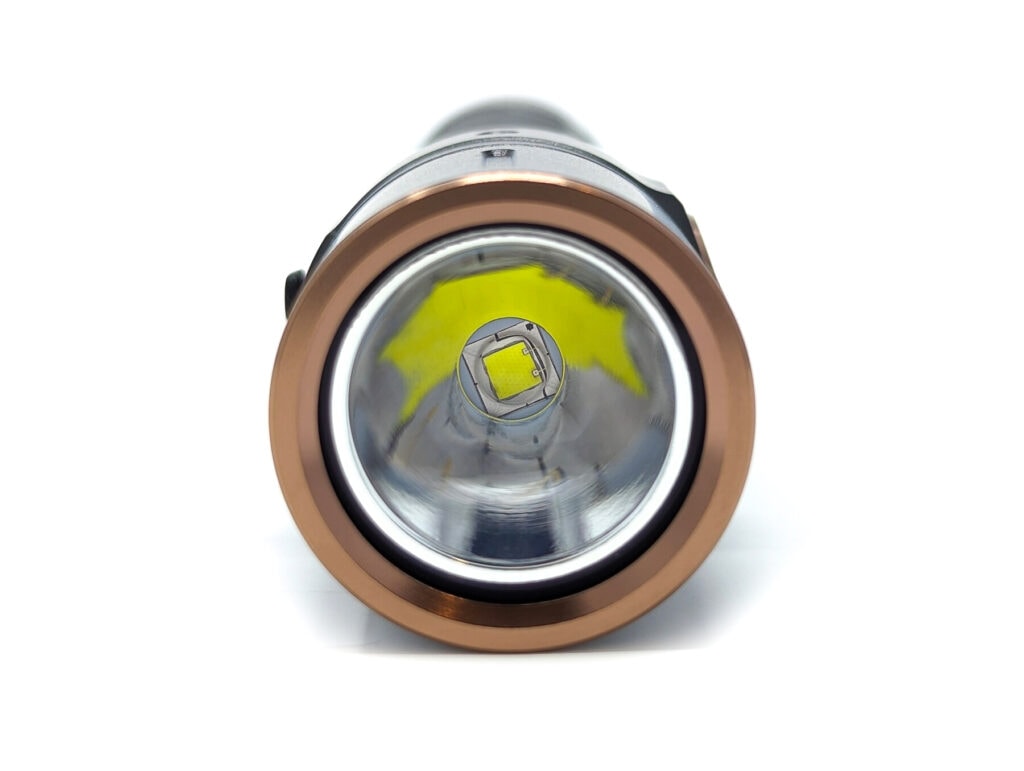
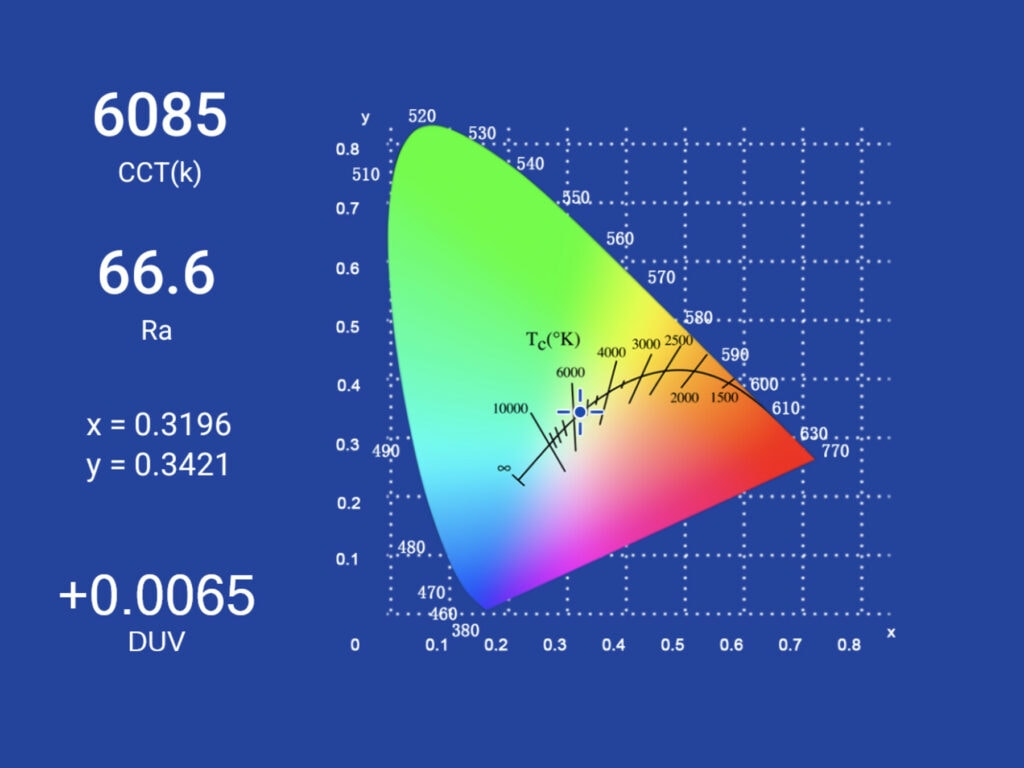
Dimensions and its competition
Dimensions:
| Fenix LD30R | Millimeters | Inches |
|---|---|---|
| Length | 130 mm | 5.1 in |
| Head diameter | 27 mm | 1.0 in |
| Body diameter | 23 mm | 0.9 in |
Dimensions are rounded to the nearest millimeter and the nearest tenth of an Inch.
Weight:
| Fenix LD30R | Weight in grams | Weight in oz |
|---|---|---|
| Without battery: | 82 g | 2.9 oz |
| With battery | 133 g | 4.7 oz |
Weight is rounded to the nearest gram and tenth of an Oz.
Flashlight size comparison with its competition:
Group 1: Fenix LD12R, Fenix LD30R, Fenix PD36R V2.0
Group 2: Sofirn SP31 V2.0, Fenix LD30R, Wurkkos FC13
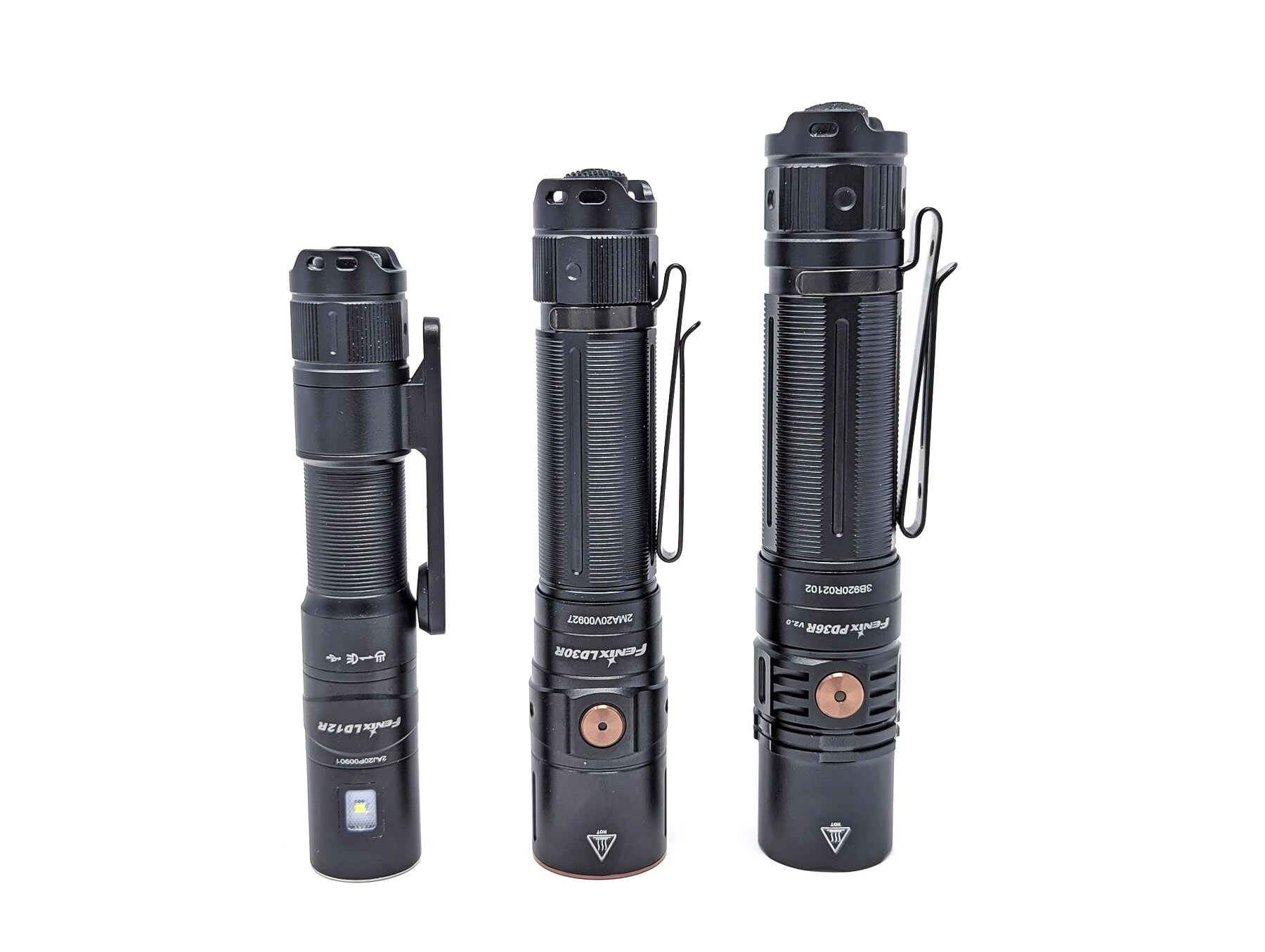
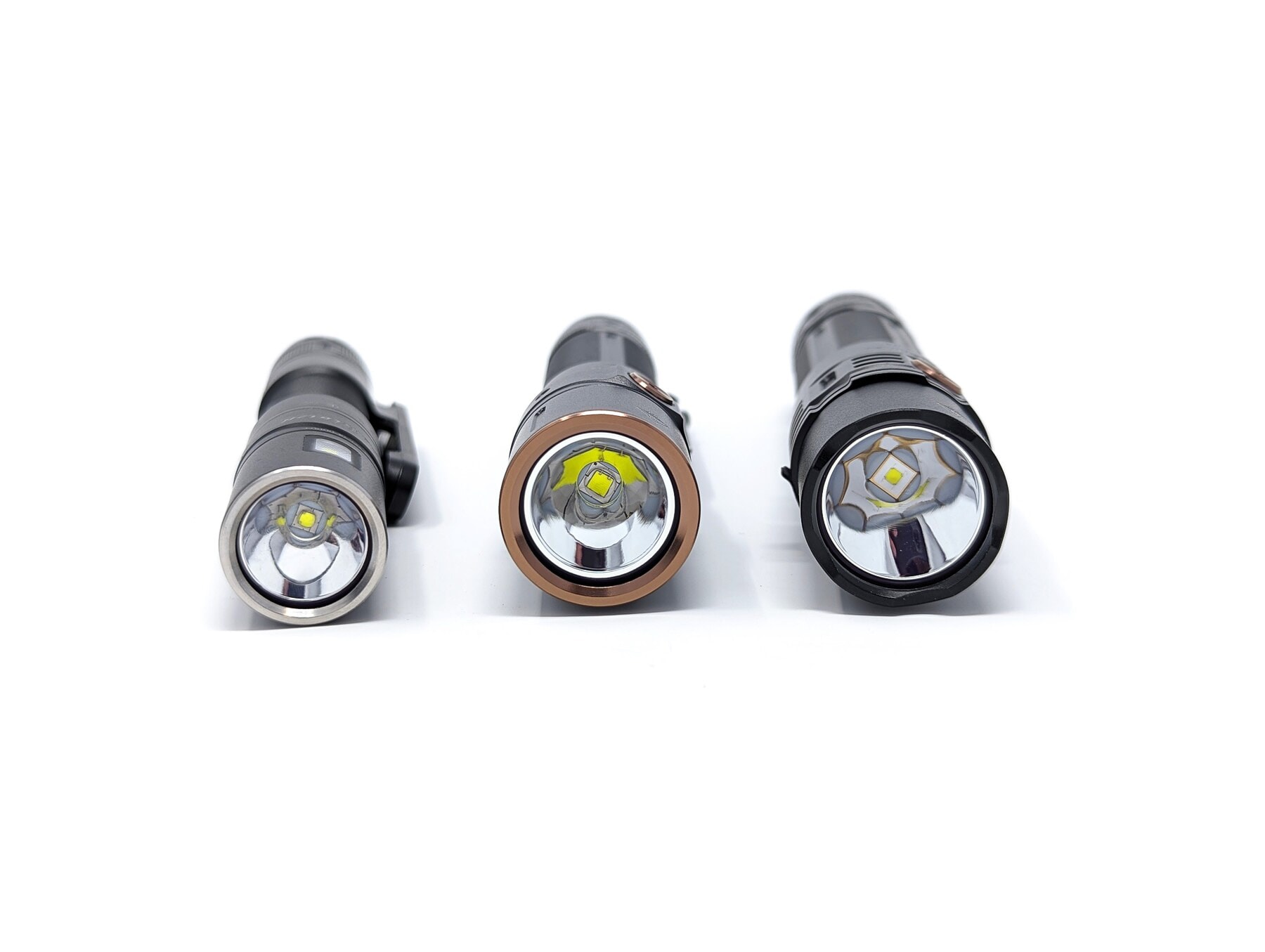
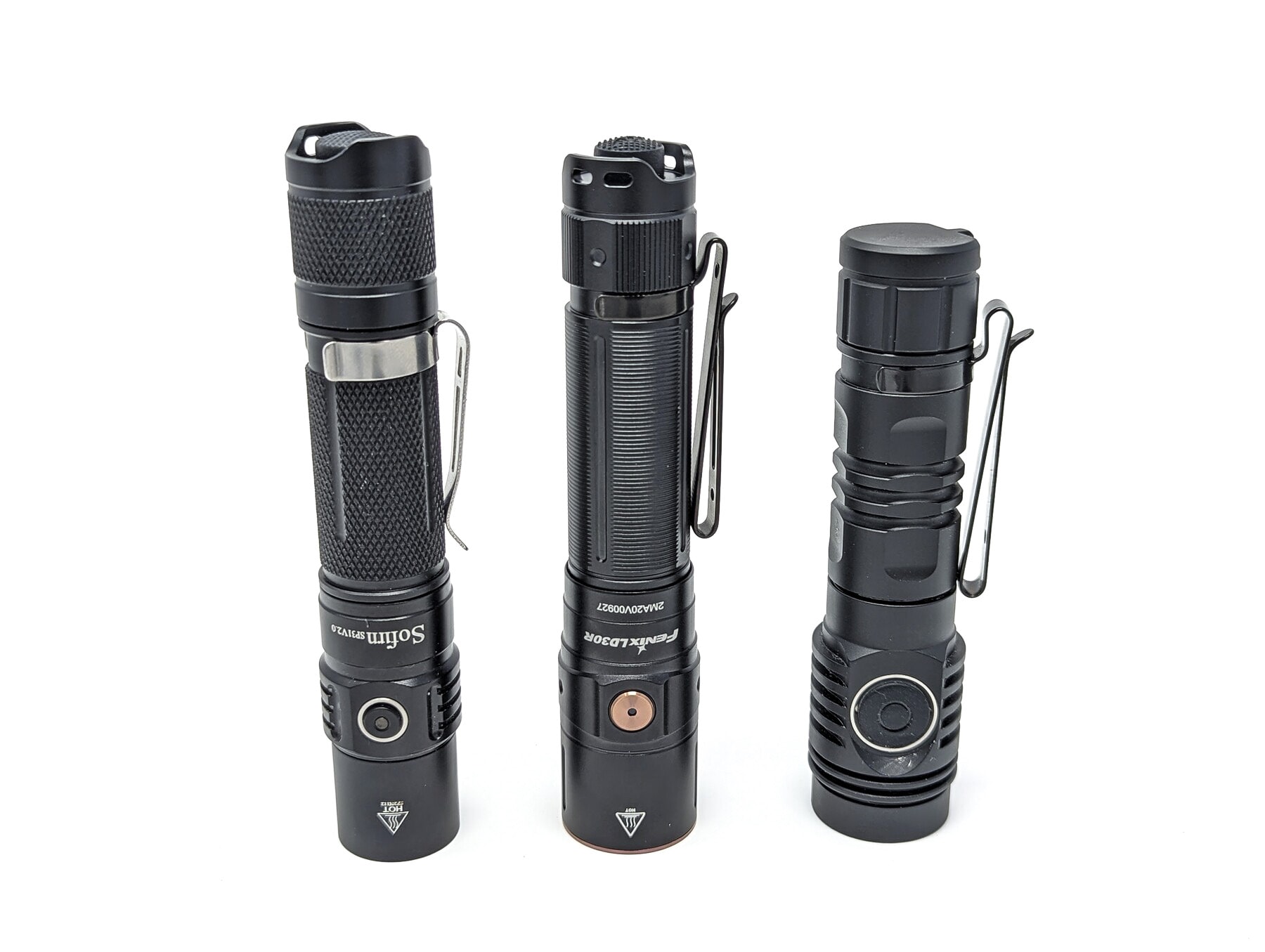
Fenix LD30R UI: User Interface and Driver
This UI is super easy to pick up, and operates pretty much how you’d expect for a no-nonsense dual-switch flashlight. The clicky switch handles on/off/momentary and the side switch is for mode switching.
Available modes:
- Eco, Low, Medium, High, Turbo
Available blinky modes:
- Strobe, SOS
From OFF:
- Tail Switch, Press and hold: momentary on
- Tail Switch, Single click: on
From ON:
- Tail Switch, Single click: off
- Side Switch, Press and hold 0.5 sec: Strobe
- Side Switch, 1 click: change modes (Eco > Low > Med > High > Turbo)
Mode memory:
- Yes, any mode can be memorized except for Strobe and SOS
Shortcuts:
- To Low: N/A
- To Turbo: N/A
- To Strobe: press and hold 0.5 sec from On
Low voltage warning/protection:
- When you turn on the flashlight, an indicator in the middle of the side switch illuminates for 3 seconds to display the battery status:
- Green, constant: between 100% and 85%
- Green, flashing: between 85% and 50%
- Red, constant: between 50% and 25%
- Red, flashing: between 25% and 1%
Strobe/blinkies
- Strobe: press and hold 0.5 sec from On
- SOS: when in Strobe mode, single click the side switch
- To exit Strobe and SOS, press and hold the side switch for 0.5 sec
Lock-out mode:
- N/A
PWM
- There is no PWM
Additional/summary info on the UI:
- There is “intelligent overheat protection” that reduces output to keep the temperature at or below 60° C
Fenix LD30R Charging and batteries
The LD30R comes with a Fenix-branded cell, the ARB-L18-3400. It is not a proprietary battery, just a button-top 3400 mAh 18650 battery with a protection circuit. While many Fenix lights have physical reverse polarity protection, the LD30R does not. It has a spring as the positive contact, which lends a bit of additional flexibility in cell length. I tried short, flat-top cells like the Samsung 30Q and they did not function properly. Slightly longer cells like a non-protected button-top Sofirn 18650 worked just fine.
Note: the Sofirn battery was a snug fit – took some effort to get it back out. Even the Fenix battery is fairly snug, but doesn’t have any issues slowly sliding out on its own.
The Fenix LD30R has built-in USB-C charging via a port on the side of the head which is covered up by a typical rubber dust plug. Fenix says that a fully depleted battery should take 3 hours to recharge when using a 5V/2A charging adapter. While charging, the indicator LED will illuminate red, then switch to green when charging is complete. In my testing, I observed a 9.3 watt charge rate (1.03A at 9.02V) and the cycle completed in 3 hours 5 minutes. The USB-C port does seem to be a little more recessed than usual, but I didn’t have any trouble charging mine.
Rant: I really wish companies like Fenix would quit using the red/green charge cycle, or at least change the charging indicator from solid red to a fading/breathing red indicator. My color deficient eyes can’t distinguish between the red/green that Fenix uses and I either end up asking for help, or just wait a sufficiently long time to where the light should be charged up. It’s really annoying though.
| Charge type | Fits | No fit | Charge time |
|---|---|---|---|
| Flashlight with onboard USB-C | Longer or button-top 18650 (eg, Sofirn button-top) | Short, flat-top 18650 (eg, Samsung 30Q) | 3h 5min |
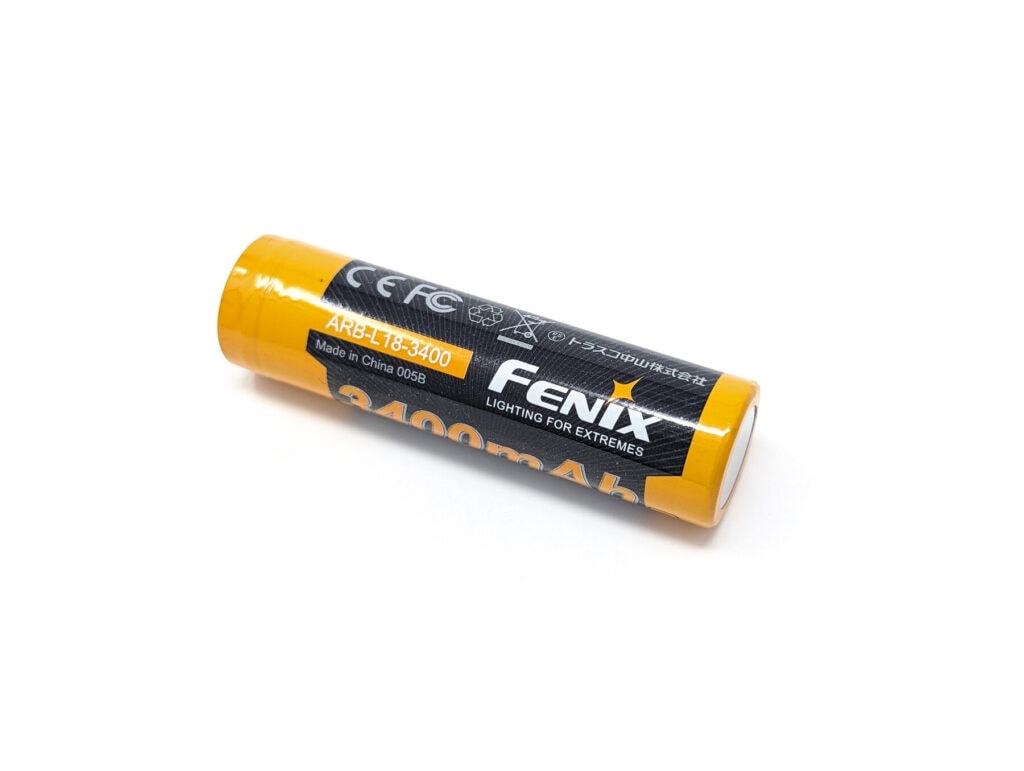
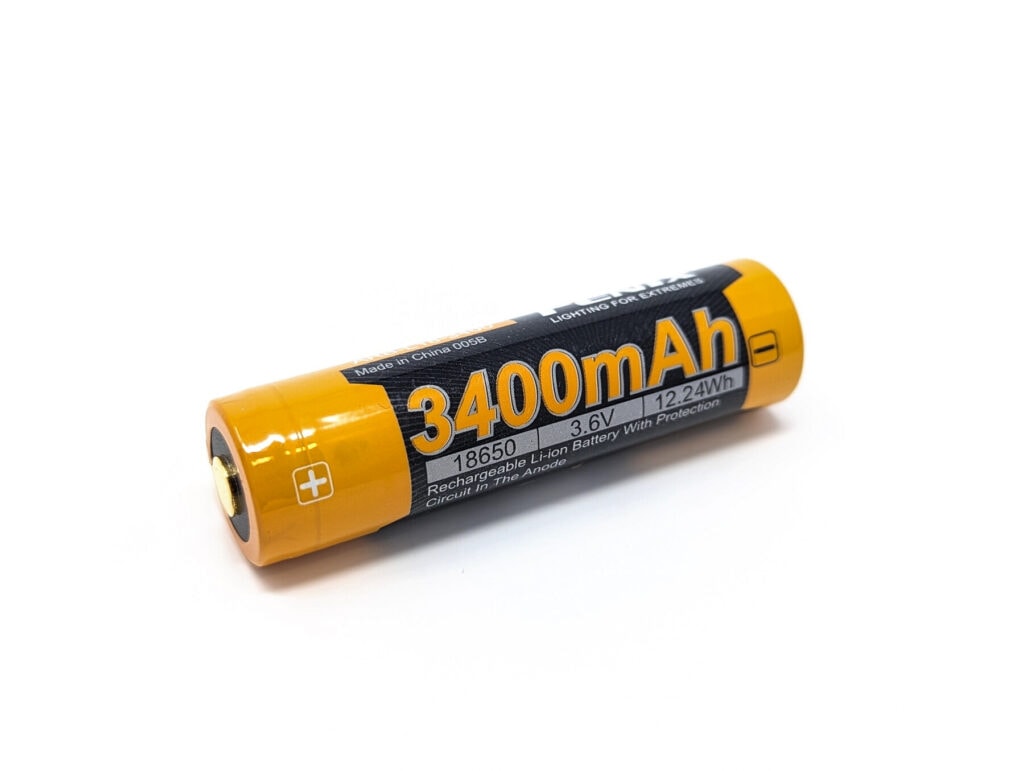
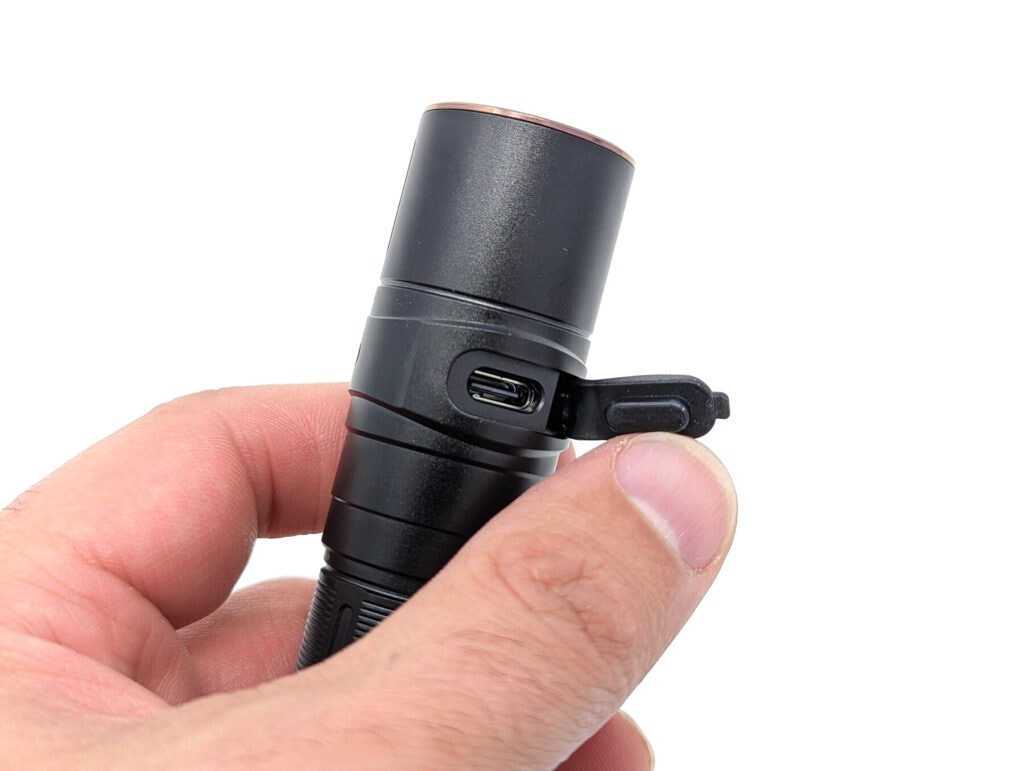
Performance test
Lumen measurements
How Lumens are Measured: Understanding ANSI FL1 Standards How Lumens are Measured: Understanding ANSI FL1 Standards: The ANSI FL1 standards specify that output in lumens should be measured 30 seconds after turning on, as this is the standardized time for measuring brightness according to the industry standard. This is why we focus on this part in our measurements. The ANSI FL1 standards require an ambient temperature of 22 ± 3°C. We record the ambient the ambient temperature to identify potential reasons for any observed discrepancies.Lux was measured by a UNI-T UT383 BT at 5 meters. Lumens were measured in a homemade lumen tube using a VEML7700 sensor, calibrated with a calibration light provided by 1Lumen. The included Fenix battery was used in the tests.
| Mode | Amps at start | Specified | 0 sec. | 30 sec. | 10 min. |
|---|---|---|---|---|---|
| Eco | 4 mA | 1 lm | 1.3 lm | 1.3 lm | – |
| Low | 95 mA | 50 lm | 49 lm | 49 lm | – |
| Med | 256 mA | 150 lm | 133 lm | 132 lm | 132 lm |
| High | 1.2 A | 600 lm | 706 lm | 701 lm | 687 lm |
| Turbo | 4.9 A | 1,700 lm | 1,962 lm | 1,823 lm | 672 lm |
| Turbo at 3.6V | 2.9 A | 1,270 lm | 1,252 lm |
Parasitic drain:
- N/A – clicky switch doesn’t have parasitic drain
The Fenix LD30R performed admirably in my tests. It exceeded the lumen specs, and the ramp-down in Turbo mode was smooth, waiting nearly 3 minutes before beginning to ramp down, and then taking nearly 3 minutes to gradually reduce the output. And High mode was able to hold almost 700 lumens for well over 2 hours without getting uncomfortably warm. I appreciate the conservative lumen specs, as well as seeing it able to hold that output for a respectable amount of time – no roller coaster effect, nor short-lived 10 seconds of fun.
Fenix LD30R Battery Life: Runtime graphs
How Runtimes are Measured: Understanding ANSI FL1 Standards About ANSI FL1 runtime standards: The runtime is measured until the light drops to 10% of its initial output (30 seconds after turning on). This does not mean that the flashlight is not usable anymore. The last column shows how long the light actually works till it shuts off. If there is a + symbol, it means that the test was stopped at that particular point, but the light was actually still running. This happens on certain occasions, with certain drivers, firmware, or batteries.| Mode | Specified | Measured runtime ANSI | Time till shut off |
|---|---|---|---|
| Eco | 750h | – | – |
| Low | 37h 25min | – | – |
| Med | 14h 40min | 14h 38min | 25h 12min+ |
| High | 2h 50min | 2h 41min | 3h 36min+ |
| Turbo | 2h 10min | 2h 8min | 3h 19min+ |
There’s no surprises here – my tests are very close to Fenix’s specs. At the end of each runtime test, the light stepped down to around 0.3 lumens because of the low battery. When I ran the Med test, I let it keep on going and it went for 10+ more hours and I eventually stopped the test. The High and Turbo tests displayed similar behavior, but I stopped those after an hour or so of 0.3 lumen output. I was initially concerned about the battery being run down too low, but when I checked it after the Med test, the battery was still at 2.84V, so still within a safe range.
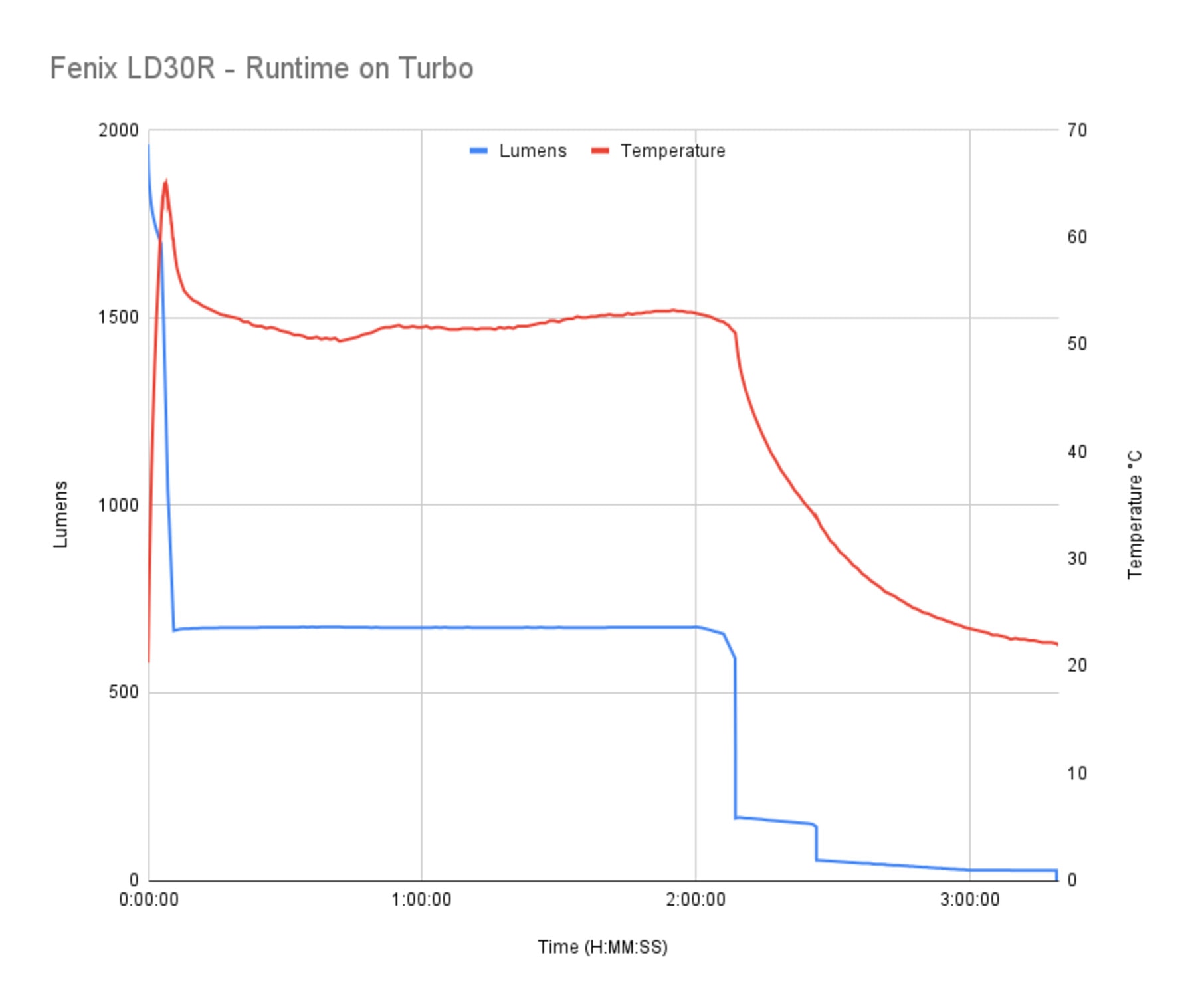
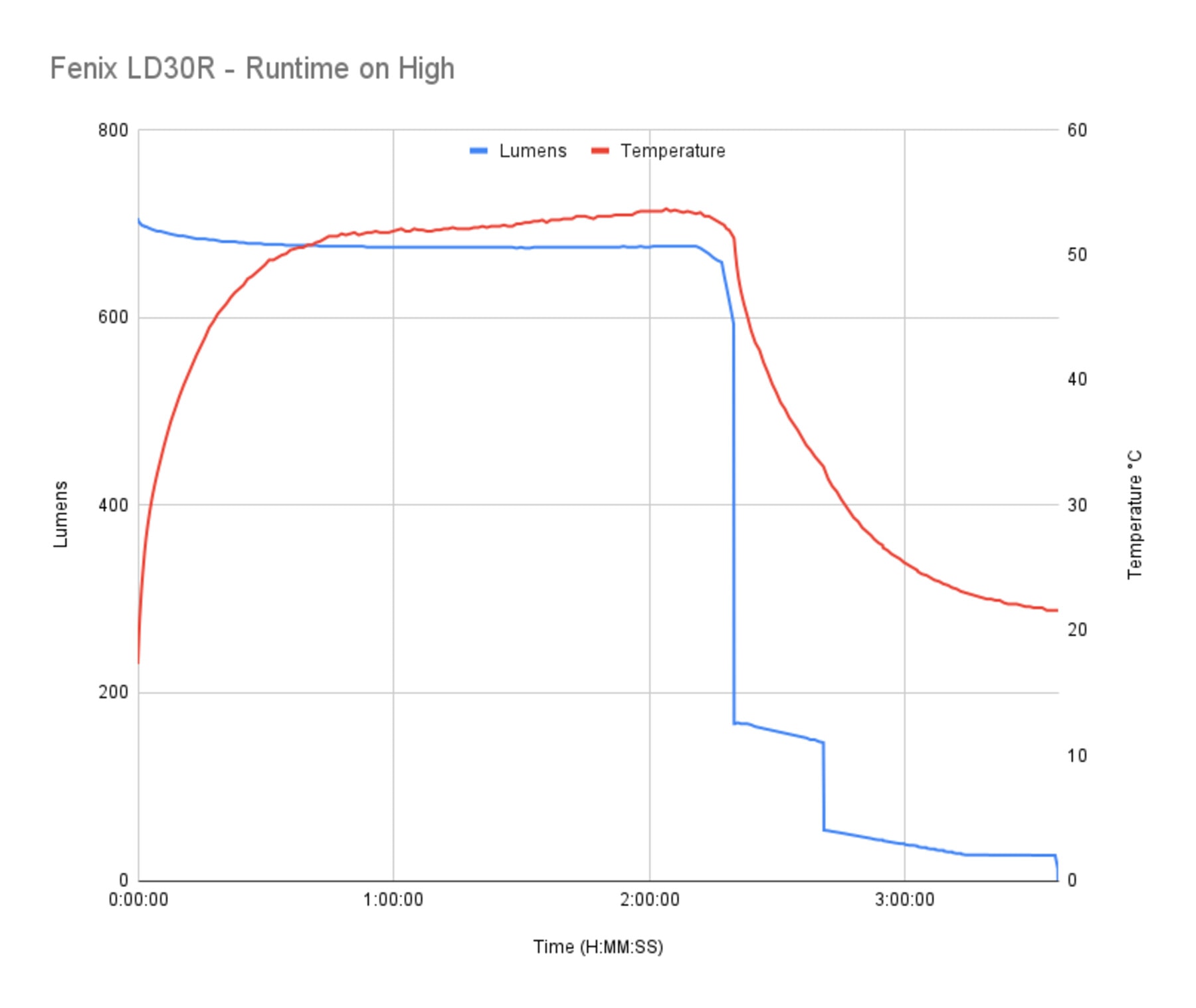
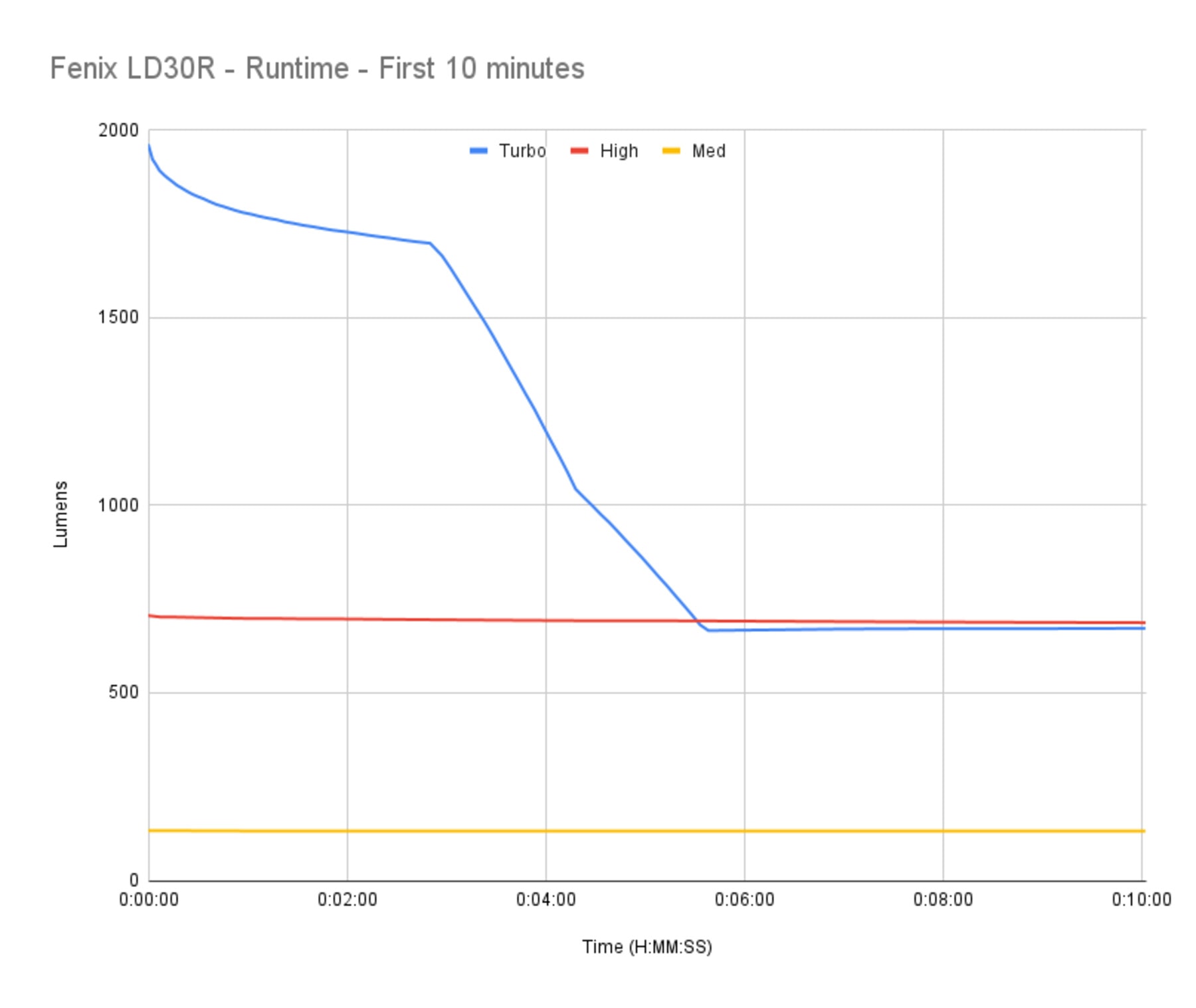
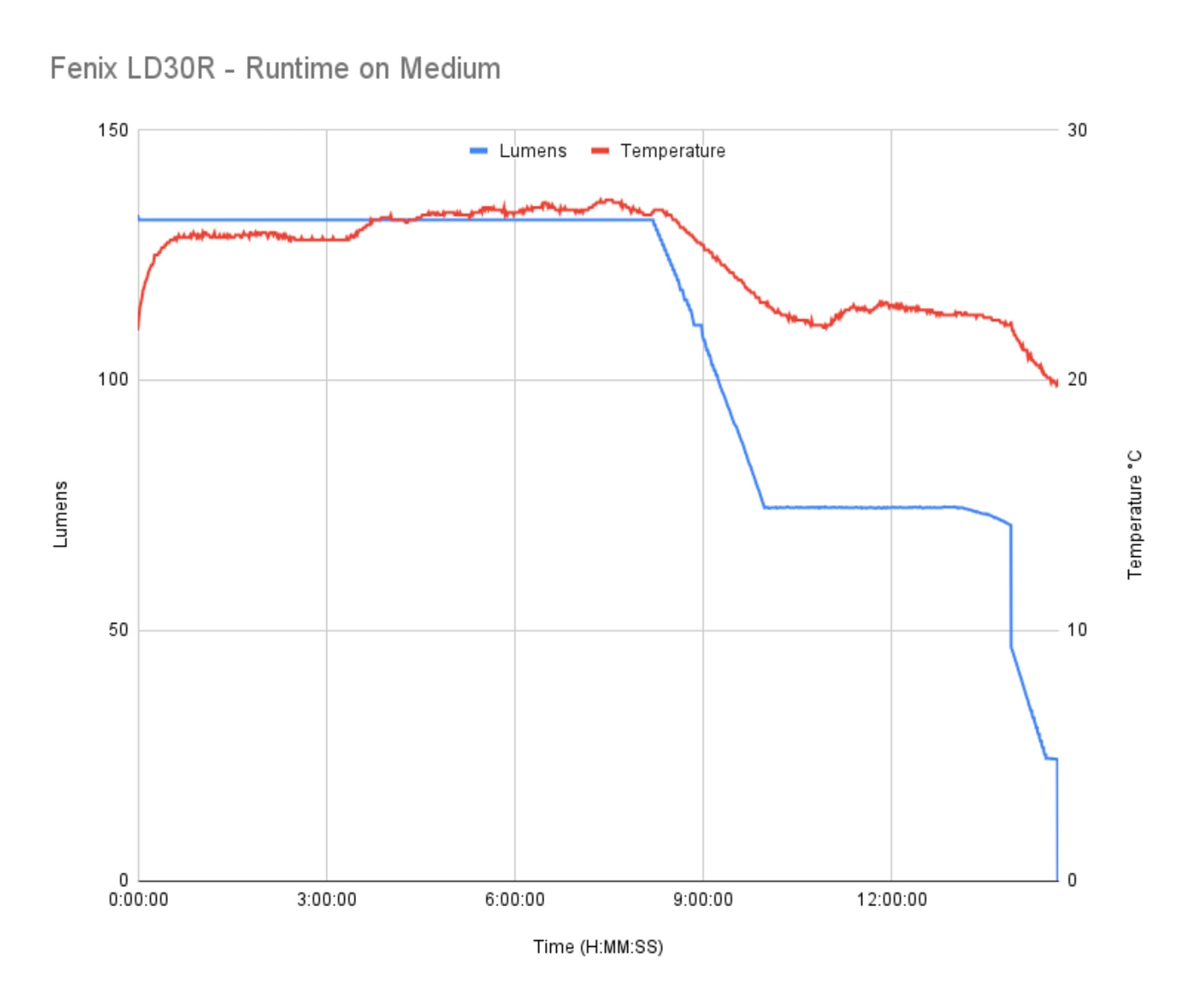
Peak beam intensity and beam distance measurements
About Peak beam intensity: Understanding ANSI FL1 Standards About peak beam intensity The calculated value of distance in meters at which the flashlight produces a light intensity of 0.25 lux. (0.25 lux is about the brightness of a full moon shining on an object). This means that the intensity has decreased so much, it becomes difficult to see darker objects, or objects that don’t reflect light. The columns ‘Meters’ and ‘Yards’ use rounded numbers.Intensity was measured at 5 meters after being turned on for 30 seconds. A UNI-T UT383 BT lux meter was used.
| Mode | Specified | Candela measured | Meters | Yards |
|---|---|---|---|---|
| Eco | 16 cd | |||
| Low | 510 cd | 525 cd | 46 m | 50 yd |
| Medium | 1,605 cd | 1,575 cd | 79 m | 87 yd |
| High | 6,500 cd | 6,450 cd | 161 m | 176 yd |
| Turbo | 18,037 cd | 17,100 cd | 262 m | 286 yd |
My intensity measurement in Turbo was just a bit lower than spec, but within what I would consider to be a reasonable margin of error. The other modes were right in line with Fenix’s claims.
Beamshots
Beam shots of the building are taken at 30 m (33 yd) using a Pixel 7 set to ISO 800 with 1/10 second exposure time
Beamshots of the following flashlights compared:
- Fenix LD30R
- Fenix PD36R V2.0
- Fenix PD36R Pro
- Olight Baton 3 Pro Max
- Maratac / Acebeam Defender P16
Please note that the following beamshots are mainly intended to showcase the beam pattern and beam quality, rather than overall performance. These images are typically taken directly after activation, and in different seasons or weather conditions, and therefore do not fully represent its overall performance. For accurate performance metrics, such as output, beam distance, and runtimes, you need to look at the performance section of this review.
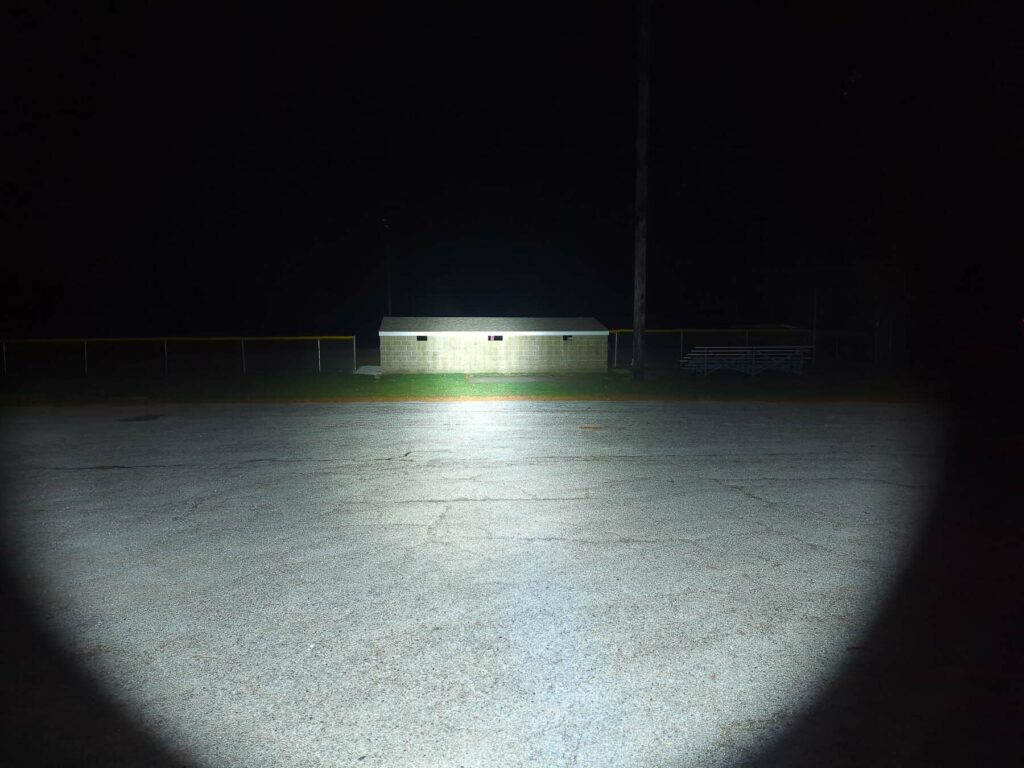
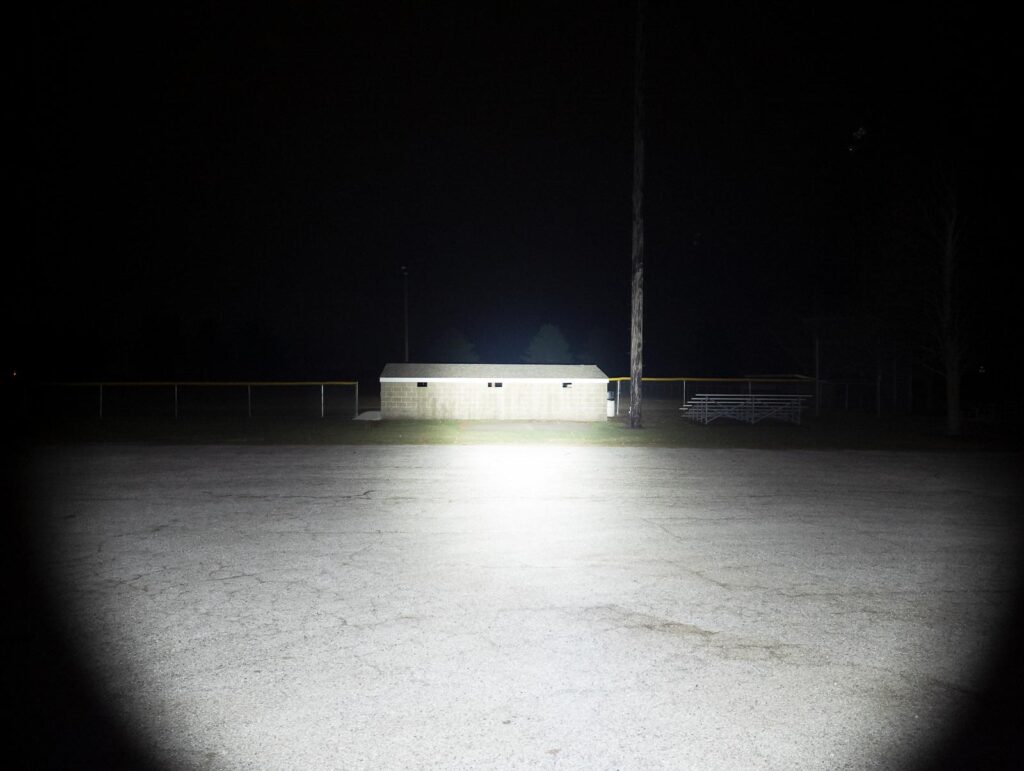
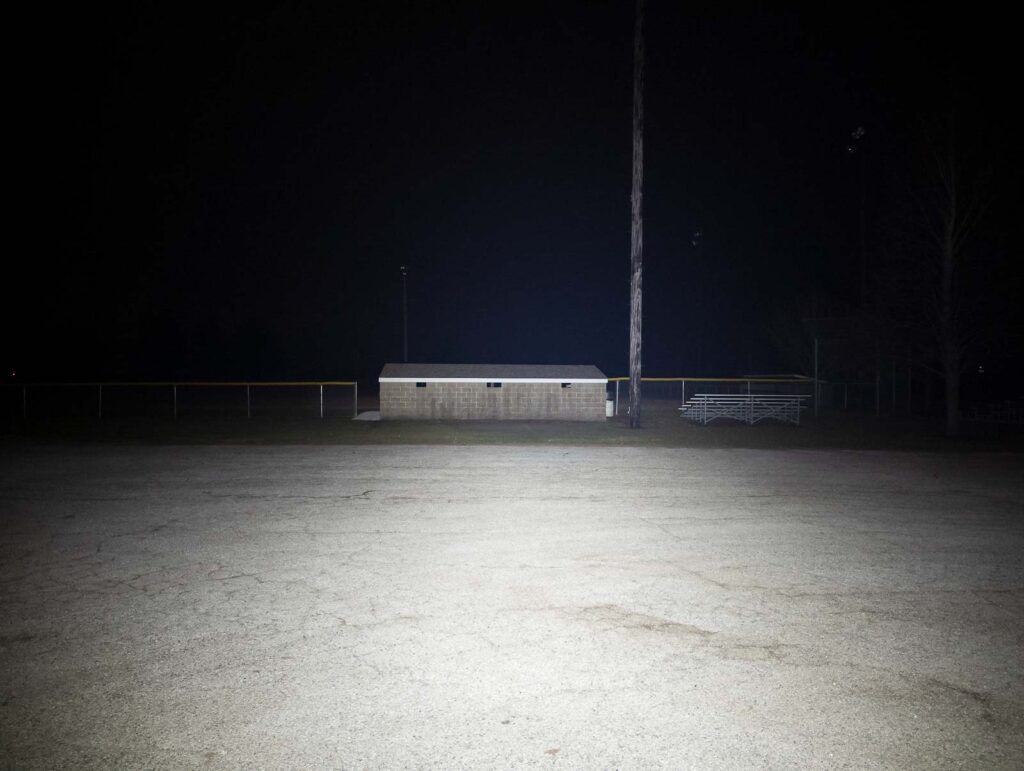
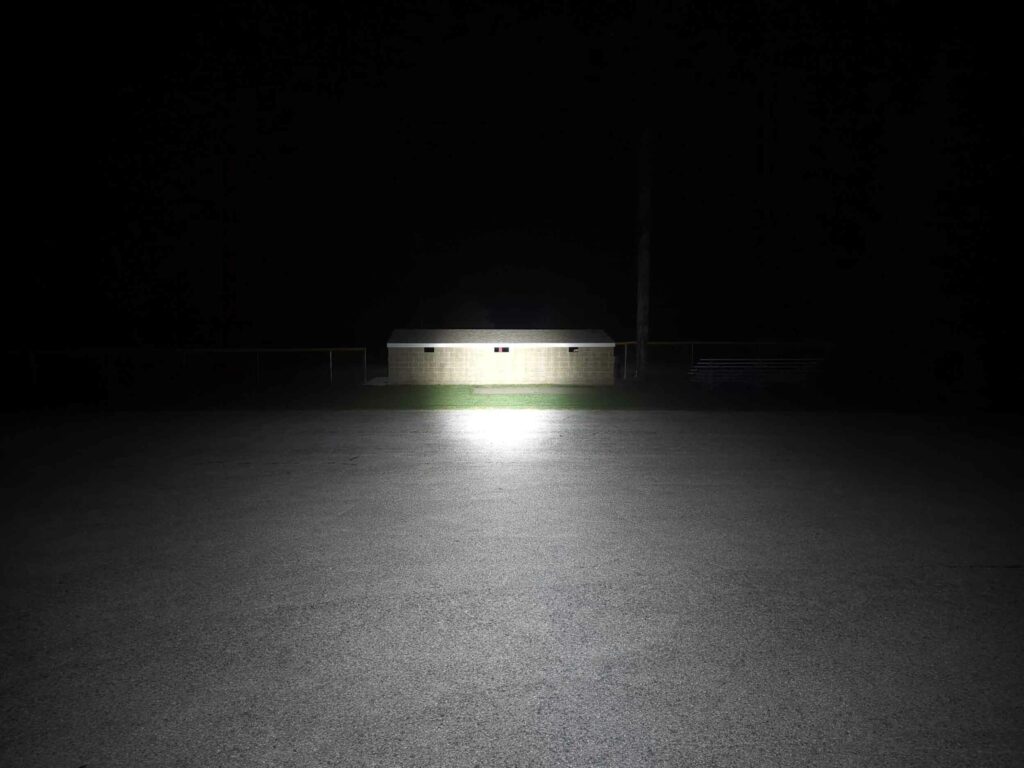
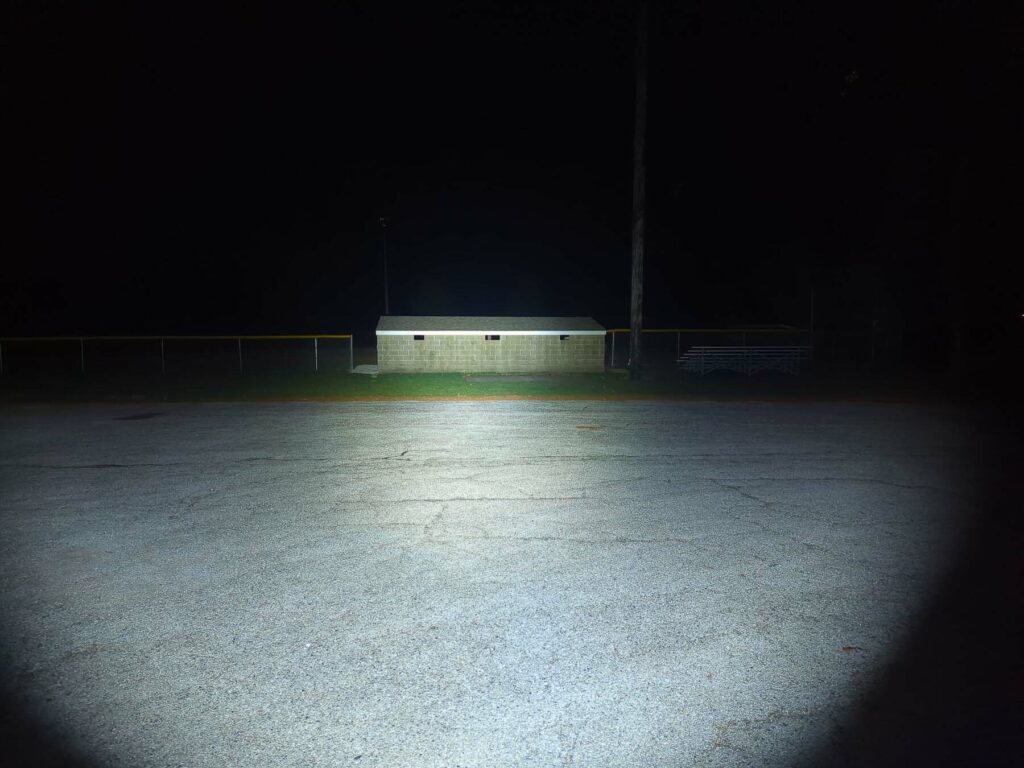
Disclaimer: This flashlight was sent to us for review at no cost by Fenix Lighting USA. We have not been paid to review, nor have we been holding back on problems or defects.
Final Verdict
Pros
- Great build quality
- Excellent regulation
- USB-C charging
- Easy dual-switch UI
- Nice balanced beam for EDC purposes
Cons
- No UI shortcuts
- Beam has some tint shift and slight green hint
Explanation on star ratings:
1: Avoid: a match would be a better choice – 2: Poor: significant defect or issues; almost unusable – 3: Average: some defects or issues; but still usable 4: Good: recommended (minor issues) – 5: Great: highly recommended

4.5 stars: ★★★★⋆
While our star rating provides a reliable indicator, we encourage you to read the full review to make an informed decision based on your own needs and preferences.
Generally speaking, Fenix knows how to make a high-quality flashlight, and the new LD30R is no exception. It’s dependable and simple enough of a light that you could hand it to almost anyone and they would have no problem figuring how to use it.
The beam created by the cool white SST40 isn’t going to win any beauty contests, but it is very functional and would work great in many real-world scenarios like dog walking, camping, or running around the backyard. If you’re looking for a utility flashlight and not a shelf queen, the Fenix LD30R is a strong contender!
Buy your Fenix LD30R with a discount
Get 10% off every purchase at Fenix Lighting US, by using our exclusive 1lumen discount code: 1lumen10
1lumen selects and reviews products personally. We may earn affiliate commissions through our links, which help support our testing.